-
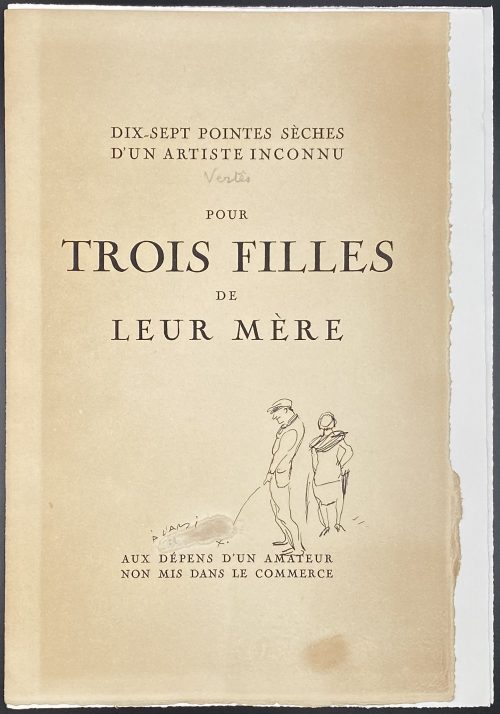 Seventeen drypoint prints in purple plus one original ink sketch by Marcel Vertés (French, 1895 – 1961) – illustrations to the book by Pierre Louÿs Trois filles de leur mère, in a paper folder. Front : DIX-SEPT POINTES SÈCHES | D'UN ARTISTE INCONNU | POUR | TROIS FILLES | DE | LEUR MÈRE | {space} | AUX DÉPENS D'UN AMATEUR | NON MIS DANS LE COMMERCE || Pencil manuscript Vertés under “ARTISTE”, autograph vignette above “AMATEUR”, erased dedication inscription above “DÉPENS” À L’AMI [erased] X. Back: JUSTIFICATION DU TIRAGE | 17 EXEMPLAIRES SUR VÉLIN D’ARCHES CONTENANT | UNE SUITE DES DIX-SEPT POINTES SÈCHES EN | NOIR : UNE SUITE EN COULEURS COLORIÉE PAR | L’ARTISTE ; UN DESSIN ORIGINAL ET SA PLANCHE | DE CUIVRE ; DIX-SEPT CROQUIS ORIGINAUX | MARQUÉS A à Q. | 50 EXEMPLAIRES SUR VÉLIN D’ARCHES CONTE- | NANT UNE SUITE DES DIX-SEPT POINTES | SÈCHES ET TROIS CROQUIS ORIGINAUX | NUMÉROTÉS DE 1 à 50. | {space} | EXEMPLAIRE № {by hand} H. C. || Size : folder 28 x 17.5 cm; sketch 26.6 x 17.6 cm; prints 27.5 x 19 cm. Printed on wove paper with MBM watermark (Arches MBM Paper). Bookplate pasted to the makeshift extra folder with title: “EX-LIBRIS | Jacques | Crepineau”. Provenance: Jacques Crepineau (French, 1932 – 2017). Description by seller: [CURIOSA - VERTÈS (Marcel)]. Dix-sept pointes sèches d'un artiste inconnu pour Trois filles de leur mère. S.l. : Aux dépens d'un amateur, [1927]. — In-8, en feuilles. Dutel 2517*. Rare suite de 17 pointes-sèches libres réalisées par Marcel VERTÈS, probablement publiée par Marcel Cotinaud. Elle était destinée à accompagner l'édition originale de Trois filles de leur mère de Pierre Louÿs publiée un an plus tôt. Tirage à 67 exemplaires sur vélin d'Arches. Les épreuves sont tirées en violet. Exemplaire sans le feuillet de titre, ni celui de la justification. Il comprend un croquis original de l'artiste, non signé, ayant servi d'étude pour l'une des planches. Selon les tirages, chaque exemplaire devrait comprendre 17 croquis pour les 17 premiers, ou 3 pour les 50 autres, non n'en avons ici qu'un seul. Envoi de Vertès sur la couverture, accompagné d'un dessin original. Le nom du destinataire a été effacé. Manque la chemise et l'étui. Description by DUTEL v.3, p. 389, № 2517: In-4 (28 x 19) de 2 ff., 17 pointes sèches, étui, chemise. … publiée en 1927 probablement par Marcel Cotinaud (SV : publisher of Vertés was Paul Cotinaud)… Les planches sont tirées en violet (SV : like this one). Tirage : 17 ex. …avec une suite coloriée par l’artiste, un dessin, un cuivre et 17 croquis. 50 ex. … avec 3 croquis. Other names: Marcel Vertès, Marcel Vertes, Marcell Vértes
Seventeen drypoint prints in purple plus one original ink sketch by Marcel Vertés (French, 1895 – 1961) – illustrations to the book by Pierre Louÿs Trois filles de leur mère, in a paper folder. Front : DIX-SEPT POINTES SÈCHES | D'UN ARTISTE INCONNU | POUR | TROIS FILLES | DE | LEUR MÈRE | {space} | AUX DÉPENS D'UN AMATEUR | NON MIS DANS LE COMMERCE || Pencil manuscript Vertés under “ARTISTE”, autograph vignette above “AMATEUR”, erased dedication inscription above “DÉPENS” À L’AMI [erased] X. Back: JUSTIFICATION DU TIRAGE | 17 EXEMPLAIRES SUR VÉLIN D’ARCHES CONTENANT | UNE SUITE DES DIX-SEPT POINTES SÈCHES EN | NOIR : UNE SUITE EN COULEURS COLORIÉE PAR | L’ARTISTE ; UN DESSIN ORIGINAL ET SA PLANCHE | DE CUIVRE ; DIX-SEPT CROQUIS ORIGINAUX | MARQUÉS A à Q. | 50 EXEMPLAIRES SUR VÉLIN D’ARCHES CONTE- | NANT UNE SUITE DES DIX-SEPT POINTES | SÈCHES ET TROIS CROQUIS ORIGINAUX | NUMÉROTÉS DE 1 à 50. | {space} | EXEMPLAIRE № {by hand} H. C. || Size : folder 28 x 17.5 cm; sketch 26.6 x 17.6 cm; prints 27.5 x 19 cm. Printed on wove paper with MBM watermark (Arches MBM Paper). Bookplate pasted to the makeshift extra folder with title: “EX-LIBRIS | Jacques | Crepineau”. Provenance: Jacques Crepineau (French, 1932 – 2017). Description by seller: [CURIOSA - VERTÈS (Marcel)]. Dix-sept pointes sèches d'un artiste inconnu pour Trois filles de leur mère. S.l. : Aux dépens d'un amateur, [1927]. — In-8, en feuilles. Dutel 2517*. Rare suite de 17 pointes-sèches libres réalisées par Marcel VERTÈS, probablement publiée par Marcel Cotinaud. Elle était destinée à accompagner l'édition originale de Trois filles de leur mère de Pierre Louÿs publiée un an plus tôt. Tirage à 67 exemplaires sur vélin d'Arches. Les épreuves sont tirées en violet. Exemplaire sans le feuillet de titre, ni celui de la justification. Il comprend un croquis original de l'artiste, non signé, ayant servi d'étude pour l'une des planches. Selon les tirages, chaque exemplaire devrait comprendre 17 croquis pour les 17 premiers, ou 3 pour les 50 autres, non n'en avons ici qu'un seul. Envoi de Vertès sur la couverture, accompagné d'un dessin original. Le nom du destinataire a été effacé. Manque la chemise et l'étui. Description by DUTEL v.3, p. 389, № 2517: In-4 (28 x 19) de 2 ff., 17 pointes sèches, étui, chemise. … publiée en 1927 probablement par Marcel Cotinaud (SV : publisher of Vertés was Paul Cotinaud)… Les planches sont tirées en violet (SV : like this one). Tirage : 17 ex. …avec une suite coloriée par l’artiste, un dessin, un cuivre et 17 croquis. 50 ex. … avec 3 croquis. Other names: Marcel Vertès, Marcel Vertes, Marcell Vértes -
 The right sheet of (optional) triptych: Geisha (Geiko) and kabuki actor Iwai Hanshirō V as Katanaya Hanshichi from Three pleasures of present-day Osaka (Tōsei Naniwa no sankō)「当世浪花の三興 芸子」 「刀屋半七」五代目岩井半四郎. Publisher: Iseya Rihei [伊勢屋利兵衛] (Japanese, fl. 1790s – c. 1879) Year: 1821 (Bunsei 4). Size: Vertical ōban; 36.5 x 25.2 cm. Signed: 於浮瀬亭国貞画 – Drawn by Kunisada in Ukabuse (Ukabuse ni oite Kunisada ga). Ukabuse is the name of a famous restaurant in Osaka, this signature can be found only on a three print bijin series [Kunisada Project]. Censor's seal: kiwame 改印:極 Actor Iwai Hanshirō V [岩井半四郎] (Japanese, 1776 – 1847); other names: Iwai Tojaku, Iwai Kumesaburō I. Character: Katanaya Hanshichi [刀屋半七] Ref: MFA ACCESSION NUMBER 11.21938; LIB-2967.2022 Izzard. Full series (triptych) Three Pleasures of Present-day Osaka (Tōsei Naniwa no sankō):
The right sheet of (optional) triptych: Geisha (Geiko) and kabuki actor Iwai Hanshirō V as Katanaya Hanshichi from Three pleasures of present-day Osaka (Tōsei Naniwa no sankō)「当世浪花の三興 芸子」 「刀屋半七」五代目岩井半四郎. Publisher: Iseya Rihei [伊勢屋利兵衛] (Japanese, fl. 1790s – c. 1879) Year: 1821 (Bunsei 4). Size: Vertical ōban; 36.5 x 25.2 cm. Signed: 於浮瀬亭国貞画 – Drawn by Kunisada in Ukabuse (Ukabuse ni oite Kunisada ga). Ukabuse is the name of a famous restaurant in Osaka, this signature can be found only on a three print bijin series [Kunisada Project]. Censor's seal: kiwame 改印:極 Actor Iwai Hanshirō V [岩井半四郎] (Japanese, 1776 – 1847); other names: Iwai Tojaku, Iwai Kumesaburō I. Character: Katanaya Hanshichi [刀屋半七] Ref: MFA ACCESSION NUMBER 11.21938; LIB-2967.2022 Izzard. Full series (triptych) Three Pleasures of Present-day Osaka (Tōsei Naniwa no sankō):


-
 Woodblock print album of thirteen prints, ōban, nishiki-e. Artist: Chōkyōsai Eiri [鳥橋斎 栄里] (Japanese, fl. c. 1789 ~ 1801 ). Models of calligraphy (Fumi no kiyogaki), New Year 1801. This title is taken from Chris Uhlenbeck's Japanese Erotic Fantasies Sexual Imagery of the Edo Period. — Hotei Publishing, 2005, ISBN 90-74822-66-5):. A detailed description of the album can be found at The Complete Ukiyo-e Shunga №9 Eiri, 1996, ISBN 4-309-91019. Most of the edition is in Japanese, though Richard Lane writes a section in English: Eiri: Love-letters, Love Consummated: Fumi-no-kiyogaki. The article starts with the following statement: "Why all the fuss about Sharaku? Because he is so "mysterious"? No, not at all: because he is such a good artist. But Sharaku is not the only great yet enigmatic ukiyo-e artist and I propose to resurrect here one of his important contemporaries who has been all too long neglected: Chōkyōsai Eiri. As with many of the notable ukiyo-e masters, nothing is known of Eiri's biography. All we can say is what we learn from his extant prints and paintings: that he flourished during the second half of the Kansei Period [1789-1801]; and that he was a direct pupil of the great Eishi - who, being of eminent samurai stock, may well have attracted pupils of similar background." Another citation from Japanese Erotic Fantasies: "This album is one of the boldest sets of ōban-size shunga known, The first edition contains thirteen instead of the customary twelve designs". Here I present all thirteen prints, though the edition I bought in Kyoto in 2014 contained only twelve. The thirteenth print was purchased later in the United States (sheet №12).
Woodblock print album of thirteen prints, ōban, nishiki-e. Artist: Chōkyōsai Eiri [鳥橋斎 栄里] (Japanese, fl. c. 1789 ~ 1801 ). Models of calligraphy (Fumi no kiyogaki), New Year 1801. This title is taken from Chris Uhlenbeck's Japanese Erotic Fantasies Sexual Imagery of the Edo Period. — Hotei Publishing, 2005, ISBN 90-74822-66-5):. A detailed description of the album can be found at The Complete Ukiyo-e Shunga №9 Eiri, 1996, ISBN 4-309-91019. Most of the edition is in Japanese, though Richard Lane writes a section in English: Eiri: Love-letters, Love Consummated: Fumi-no-kiyogaki. The article starts with the following statement: "Why all the fuss about Sharaku? Because he is so "mysterious"? No, not at all: because he is such a good artist. But Sharaku is not the only great yet enigmatic ukiyo-e artist and I propose to resurrect here one of his important contemporaries who has been all too long neglected: Chōkyōsai Eiri. As with many of the notable ukiyo-e masters, nothing is known of Eiri's biography. All we can say is what we learn from his extant prints and paintings: that he flourished during the second half of the Kansei Period [1789-1801]; and that he was a direct pupil of the great Eishi - who, being of eminent samurai stock, may well have attracted pupils of similar background." Another citation from Japanese Erotic Fantasies: "This album is one of the boldest sets of ōban-size shunga known, The first edition contains thirteen instead of the customary twelve designs". Here I present all thirteen prints, though the edition I bought in Kyoto in 2014 contained only twelve. The thirteenth print was purchased later in the United States (sheet №12). №1: "...one of the most exotic scenes in all shunga. A Dutch kapitan is discovered coupling with a lovely Japanese courtesan, beside a large window opening upon a garden...".
№1: "...one of the most exotic scenes in all shunga. A Dutch kapitan is discovered coupling with a lovely Japanese courtesan, beside a large window opening upon a garden...".

 №2: "...a fair young harlot is seen masturbating with a grinding-pestle - a man watches intently from under bedding." [I have two specimens of this design; the one from album is more soiled but less faded].
№2: "...a fair young harlot is seen masturbating with a grinding-pestle - a man watches intently from under bedding." [I have two specimens of this design; the one from album is more soiled but less faded].
 №3: "...the artist has effectively contrasted the lovers by depicting the man's face as seen through the geisha's gauze skirt. [...] we are impressed more by strikingly elegant composition, the dramatic coloring, rather than feeling any great urge to participate in the energetic proceedings..."
№3: "...the artist has effectively contrasted the lovers by depicting the man's face as seen through the geisha's gauze skirt. [...] we are impressed more by strikingly elegant composition, the dramatic coloring, rather than feeling any great urge to participate in the energetic proceedings..."
 №4: "This scene is a most straightforward one, featuring the standard Missionary Position [capitalization by R. Lane].; but withal, the contrast of the young and naked, secret lover and the richly-clothed courtesan amid luxurious bedding..."
№4: "This scene is a most straightforward one, featuring the standard Missionary Position [capitalization by R. Lane].; but withal, the contrast of the young and naked, secret lover and the richly-clothed courtesan amid luxurious bedding..."
 №5: "In a striking lesbian scene (which has no equivalent in Utamaro, and is, incidentally, often omitted in later editions of this album), the girl at left prepares to receive the harikata (dildo) worn by the older girl at right (who holds a seashell containing lubricant)."
№5: "In a striking lesbian scene (which has no equivalent in Utamaro, and is, incidentally, often omitted in later editions of this album), the girl at left prepares to receive the harikata (dildo) worn by the older girl at right (who holds a seashell containing lubricant)."
 №6: "In the first appearance of a matronly heroine in this series, we find a widow - with shaven eyebrows and clipped hair - sporting with a handsome yound shop-clerk, mounting him with all her might."
№6: "In the first appearance of a matronly heroine in this series, we find a widow - with shaven eyebrows and clipped hair - sporting with a handsome yound shop-clerk, mounting him with all her might."

 №7: "... lady of samurai court: here, shown taking advantage of an official outing to temple and theatre, to rendezvous with a secret lover on a teahouse balcony." R. Lane considers this design the least successful in the series, especially in comparison with the same theme by Utamaro: "Utamaro female is almost ferocious in her lust for sexual gratification", which does not sound true to me. See Utamaro's sheet №5 from the album Utamakura (歌まくら, Poem of the Pillow) [courtesy The British Museum without permission]:
№7: "... lady of samurai court: here, shown taking advantage of an official outing to temple and theatre, to rendezvous with a secret lover on a teahouse balcony." R. Lane considers this design the least successful in the series, especially in comparison with the same theme by Utamaro: "Utamaro female is almost ferocious in her lust for sexual gratification", which does not sound true to me. See Utamaro's sheet №5 from the album Utamakura (歌まくら, Poem of the Pillow) [courtesy The British Museum without permission]:
 Then, as Richard Lane states, "we are flung suddenly to the bottom rung of Edo society":
Then, as Richard Lane states, "we are flung suddenly to the bottom rung of Edo society":
 №8: "Here we find a fair yotaka ('night-hawk', e.i. streetwalker) accommodating a lusty client in a lumberyard by the bank of the Sumida River".
№8: "Here we find a fair yotaka ('night-hawk', e.i. streetwalker) accommodating a lusty client in a lumberyard by the bank of the Sumida River".
 №9: '... a slightly plump harlot of the lower class receives a night visit from her lover, whose naked form she tries to cover with a cloak."
№9: '... a slightly plump harlot of the lower class receives a night visit from her lover, whose naked form she tries to cover with a cloak."
 №10: "...likely maidservant and lackey - are depicted in bath-room, their passions are all too obviously fired by steaming water."
№10: "...likely maidservant and lackey - are depicted in bath-room, their passions are all too obviously fired by steaming water."
 №11: "...this scene of courtesan and secret lover ranks high not only in Eiri's œuvre but also in the annals of the ukiyo-e genre itself. Both design and colouring are impeccable and, for this period, there is nothing even in the work of great Utamaro that really surpasses it." Again, a doubtful statement, however, this is Utamaro's design for the reader to judge:
№11: "...this scene of courtesan and secret lover ranks high not only in Eiri's œuvre but also in the annals of the ukiyo-e genre itself. Both design and colouring are impeccable and, for this period, there is nothing even in the work of great Utamaro that really surpasses it." Again, a doubtful statement, however, this is Utamaro's design for the reader to judge:
 The last design in my album is this:
The last design in my album is this:
 #13: In most reference books it goes under number 13, and we will assign this number to the sheet. "The final scene of the album features naked participants, probably samurai man and wife. The print is rather subdued in tone and colour, if not in the degree of the passion displayed..."
An additional sheet, acquired separately from a reputable dealer in New York, is usually listed as №12:
#13: In most reference books it goes under number 13, and we will assign this number to the sheet. "The final scene of the album features naked participants, probably samurai man and wife. The print is rather subdued in tone and colour, if not in the degree of the passion displayed..."
An additional sheet, acquired separately from a reputable dealer in New York, is usually listed as №12:
 №12: "One might think that Eiri has reached his peak with the preceding plate 11 - and indeed he has, in both esthetic and erotic terms. But the album is not yet finished, and the next scene lends a needed variety to the series, a slightly comic tableau featuring a middle-aged lackey attempting to forcibly seduce a servant girl of the same domicile". Utamaro's design, that inspired Eiri is here:
№12: "One might think that Eiri has reached his peak with the preceding plate 11 - and indeed he has, in both esthetic and erotic terms. But the album is not yet finished, and the next scene lends a needed variety to the series, a slightly comic tableau featuring a middle-aged lackey attempting to forcibly seduce a servant girl of the same domicile". Utamaro's design, that inspired Eiri is here:
 All descriptions are taken from Richard Lane's article at The Complete Ukiyo-e Shunga №9 Eiri, 1996. He concluded: "...Eiri's erotic series represents a major contribution to shunga art towards the close of ukiyo-e "Golden Age". In part inspired by Utamaro's classic album, this series withal constitutes a unified and original achievement, providing a cumulative effect of gracefully elegant yet glowing eroticism, which remains in the mind's eye long after the pictures themselves are far away."
I only would like to mention here that in several reference sources this album goes under name of Eisho; unfortunately, this mistake is reproduced at www.ukiyo-e.org, which miraculously shows exactly my print, but under the wrong name of the artist. The same mistake can be found at Shunga. The art of love in Japan. Tom and Mary Anne Evans. Paddington Press Ltd., 1975. ISBN 0-8467-0066-2; plates 6.74-6.77: Chōkyōsai Eishō, c. 1800. Even the British Museum edition of 2010 gives the same erroneous attribution: Chōkyōsai Eishō (1793-1801); they provide the following translation of title: "Clean Draft of a Letter" [see: Shunga. Erotic art in Japan. Rosina Buckland. The British Museum Press, 2010; pp. 110-112]. To the honour of the British Museum, I must admit that they have corrected themselves in Shunga. Sex and pleasure in Japanese art. Edited by Timothy Clark, et al. Hotei Publishing, 2013. Now, they say Chōkyōsai Eiri (worked c. 1790s-1801); they also provide a new title: "Neat Version of the Love Letter, or Pure Drawings of Female Beauty". I have already mentioned Richard Lane's version of title: "Love-letters, Love Consummated", and Chris Uhlenbeck's "Models of calligraphy". In poorly designed and printed Shunga. Erotic figures in Japanese art. Presented by Gabriele Mandel. Translated by Alison L'Eplattenier. Crescent Books, New York, 1983, the artist is named Shokyosai Eisho (beginning of the 19th century); title provided: "Models of Calligraphy". Correct attribution to Chōkyōsai Eiri also can be found at Poem of the pillow and other stories by Utamaro, Hokusai, Kuniyoshi and other artists of the floating world. Gian Carlo Calza in collaboration with Stefania Piotti. Phaidon Press, 2010; though the title is translated as "Clean Copy of Female Beauty".
All descriptions are taken from Richard Lane's article at The Complete Ukiyo-e Shunga №9 Eiri, 1996. He concluded: "...Eiri's erotic series represents a major contribution to shunga art towards the close of ukiyo-e "Golden Age". In part inspired by Utamaro's classic album, this series withal constitutes a unified and original achievement, providing a cumulative effect of gracefully elegant yet glowing eroticism, which remains in the mind's eye long after the pictures themselves are far away."
I only would like to mention here that in several reference sources this album goes under name of Eisho; unfortunately, this mistake is reproduced at www.ukiyo-e.org, which miraculously shows exactly my print, but under the wrong name of the artist. The same mistake can be found at Shunga. The art of love in Japan. Tom and Mary Anne Evans. Paddington Press Ltd., 1975. ISBN 0-8467-0066-2; plates 6.74-6.77: Chōkyōsai Eishō, c. 1800. Even the British Museum edition of 2010 gives the same erroneous attribution: Chōkyōsai Eishō (1793-1801); they provide the following translation of title: "Clean Draft of a Letter" [see: Shunga. Erotic art in Japan. Rosina Buckland. The British Museum Press, 2010; pp. 110-112]. To the honour of the British Museum, I must admit that they have corrected themselves in Shunga. Sex and pleasure in Japanese art. Edited by Timothy Clark, et al. Hotei Publishing, 2013. Now, they say Chōkyōsai Eiri (worked c. 1790s-1801); they also provide a new title: "Neat Version of the Love Letter, or Pure Drawings of Female Beauty". I have already mentioned Richard Lane's version of title: "Love-letters, Love Consummated", and Chris Uhlenbeck's "Models of calligraphy". In poorly designed and printed Shunga. Erotic figures in Japanese art. Presented by Gabriele Mandel. Translated by Alison L'Eplattenier. Crescent Books, New York, 1983, the artist is named Shokyosai Eisho (beginning of the 19th century); title provided: "Models of Calligraphy". Correct attribution to Chōkyōsai Eiri also can be found at Poem of the pillow and other stories by Utamaro, Hokusai, Kuniyoshi and other artists of the floating world. Gian Carlo Calza in collaboration with Stefania Piotti. Phaidon Press, 2010; though the title is translated as "Clean Copy of Female Beauty".
-
 Suzuki Harunobu (鈴木 春信; c. 1725 – 15 July 1770).
Suzuki Harunobu (鈴木 春信; c. 1725 – 15 July 1770).The Ide Jewel River, a Famous Place in Yamashiro Province (Ide no Tamagawa, Yamashiro no meisho), from the series The Six Jewel Rivers in Popular Customs (Fûzoku Mu Tamagawa).
Signed: Harunobu gaInscription - Poem: Koma tomete/ nao mizu kawan/ yamabuki no/ hana no tsuyu sou/ Ide no Tamagawa
References:MFA # 21.4540.
Waterhouse cat. #562; Pins, The Japanese Pillar Print (1982), #139; Ukiyo-e shûka 4 (1979), list #795.4, and supp. 2 (1982), pl. 565; Gentles, AIC cat. II (1965), p. 125, #201.
-
 Ogata Gekkō [尾形月耕] (Japanese, 1859 – 1920). An uchiwa-e (fan-print) of advertisement of tobacco of Kagoshima Prefecture, c. 1890 (Meiji Period). Barefoot Tengu* is sitting on a torii (entrance to a Shinto shrine), smoking a cigarette through a mouthpiece. _______ * Tengu [天狗] (heavenly dog) is a type of legendary creature found in Japanese folk religion and are also considered a type of Shinto god (kami) or yōkai (supernatural beings).
Ogata Gekkō [尾形月耕] (Japanese, 1859 – 1920). An uchiwa-e (fan-print) of advertisement of tobacco of Kagoshima Prefecture, c. 1890 (Meiji Period). Barefoot Tengu* is sitting on a torii (entrance to a Shinto shrine), smoking a cigarette through a mouthpiece. _______ * Tengu [天狗] (heavenly dog) is a type of legendary creature found in Japanese folk religion and are also considered a type of Shinto god (kami) or yōkai (supernatural beings). -
 Artist: Utagawa Kunisada [歌川 国貞] a.k.a. Utagawa Toyokuni III [三代 歌川 豊国] (Japanese, 1786 – 1865). An untrimmed fan print titled Fuji Tsukuba aiaigasa, shows the actors Ichikawa Ebizo V [市川海老蔵] and the onnagata actor Iwai Shijaku I [岩井紫若] sharing an umbrella against the wind. Tsukuba, about 50 kilometres from Edo, was an area where both Fuji and Mount Tsukuba could be viewed together. Mount Fuji being the female and Mount Tsukuba the male. An aizuri-e background (common to all the designs in this set). A play on images and words. Actors: Ichikawa Danjūrō VII [市川団十郎] (Japanese, 1791 – 1859); other names: Ichikawa Ebizō V [市川海老蔵], Ichikawa Hakuen II, Ichikawa Shinnosuke I. Iwai Matsunosuke I [岩井松之助] (Japanese, 1804 – 1845); other names: Iwai Hanshirō VII, Iwai Shijaku I [岩井紫若], Iwai Komurasaki I. Publisher: Ibaya Senzaburo [伊場屋仙三郎] (Japanese, fl. c. 1845 – 1847). The publisher’s seal is on the umbrella. Date: circa 1832. Signed: Kōchōrō Kunisada ga in a red double-gourd cartouche. From the series of fan prints:
Artist: Utagawa Kunisada [歌川 国貞] a.k.a. Utagawa Toyokuni III [三代 歌川 豊国] (Japanese, 1786 – 1865). An untrimmed fan print titled Fuji Tsukuba aiaigasa, shows the actors Ichikawa Ebizo V [市川海老蔵] and the onnagata actor Iwai Shijaku I [岩井紫若] sharing an umbrella against the wind. Tsukuba, about 50 kilometres from Edo, was an area where both Fuji and Mount Tsukuba could be viewed together. Mount Fuji being the female and Mount Tsukuba the male. An aizuri-e background (common to all the designs in this set). A play on images and words. Actors: Ichikawa Danjūrō VII [市川団十郎] (Japanese, 1791 – 1859); other names: Ichikawa Ebizō V [市川海老蔵], Ichikawa Hakuen II, Ichikawa Shinnosuke I. Iwai Matsunosuke I [岩井松之助] (Japanese, 1804 – 1845); other names: Iwai Hanshirō VII, Iwai Shijaku I [岩井紫若], Iwai Komurasaki I. Publisher: Ibaya Senzaburo [伊場屋仙三郎] (Japanese, fl. c. 1845 – 1847). The publisher’s seal is on the umbrella. Date: circa 1832. Signed: Kōchōrō Kunisada ga in a red double-gourd cartouche. From the series of fan prints:
Two more prints from the series 'Fuji and Tsukuba sharing an umbrella' (Fuji Tsukuba aiaigasa), not in this Collection:
SVJP-0341.2021

Kabuki actors Onoe Kikugorō III and Iwai Kumesaburo II. Year: c. 1832; Publisher: No seal; Signed: Kōchōrō Kunisada ga From Kunisada Project. 
Kabuki actors Bandō Minosuke II and Iwai Shijaku I. Year: c. 1832; Publisher: No seal; Signed: Kōchōrō Kunisada ga From Kunisada Project. -
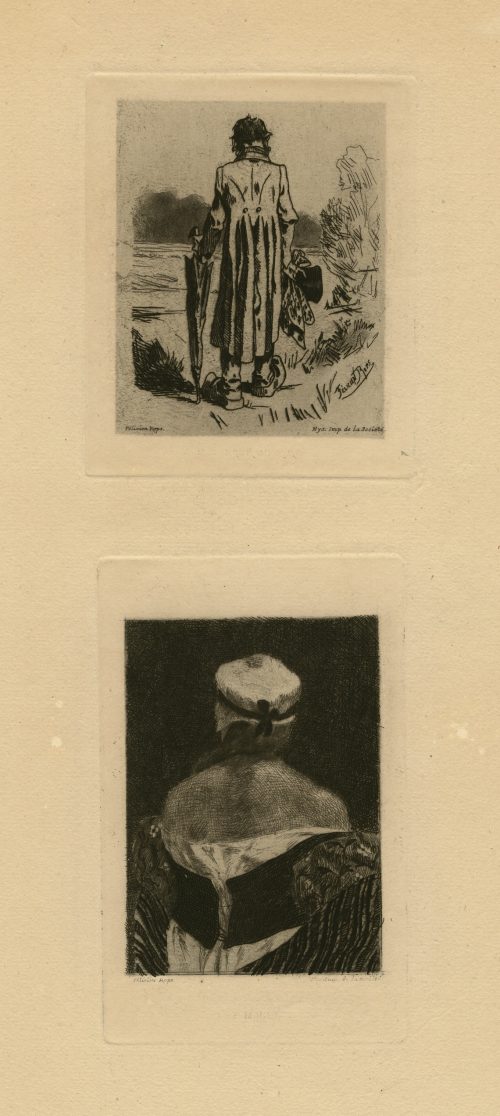
Two images printed on one sheet of van Gelder wove paper. Owner's stamp 'LvM' on verso.
Dimensions: Paper: 46.7 x 31 cm; top Mon bourgmestre: 11 x 9 cm plate, 9 x 7.5 cm image; Bottom Le modèle: 13.5 x 8.5 cm plate, 10 x 7 cm image.
Catalogue raisonné: Arthur Hubschmid (1977): 341 & 342; Rouir 425:4 & 517:7.
-
 Title: On the Banks of the Kamo River [加茂堤] (Kamo Tsutsumi), sometimes transcribed as Kamo Zutsumi. Series: A Parody of Sugawara [美立菅原] (Mitate Sugawara). The word mitate is usually written as 見立 but here it is 美立, like on another Kunisada's fan print A beauty reading a book on a balcony overlooking a bay: A Parody of Sugawara Stripes (see SVJP-0334.2021 in this collection). On the Banks of the Kamo River is a scene from the play Sugawara's Secrets of Calligraphy [菅原伝授手習鑑] (Sugawara Denju Tenarai Kagami); it was originally written for the puppet theatre (Bunraku) and staged for the first time in the 8th lunar month of 1746 in Ôsaka at the Takemotoza. It was adapted for Kabuki the following month and staged for the first time in Kyôto at the Kitagawa no Shibai, produced by Nakamura Kiyosaburô I. It was also performed for the first time in Edo, at the Ichimuraza, in the 3rd lunar month of 1747. The shape of the cartouche resembles an ox cart viewed from the back which alludes to the scene Fighting for the Carriage (Kuruma biki). Artist: Utagawa Kunisada [歌川 国貞] a.k.a. Utagawa Toyokuni III [三代 歌川 豊国] (Japanese, 1786 – 1865). Signed: Toyokuni [豊国] in a red toshidama cartouche. The character ga [画] is missing (cut out). Publisher’s seal: Ibaya Senzaburō [伊場屋仙三郎] (Japanese, fl. 1815 – 1869). The date seal and censor seals were possibly trimmed out. According to [LIB-3008.2022] Andreas Marks (Tuttle, 2010; p. 267), the series was produced by Ibaya in 1851. Ref.: (1) Samuel L. Leiter. Historical dictionary of Japanese traditional theatre (Historical dictionaries of literature and the arts) / 2nd edition. – Lanham: Rowman & Littlefield, 2014©. (2) Andreas Marks. Japanese woodblock prints: Artists, publishers and masterworks, 1680 – 1900 / Foreword by Stephen Addiss. — Tuttle Publishing, 2010©. Acknowledgements: This masterpiece of ukiyo-e would not be properly described without input from Elena Varshavsky and Horst Graebner.
Title: On the Banks of the Kamo River [加茂堤] (Kamo Tsutsumi), sometimes transcribed as Kamo Zutsumi. Series: A Parody of Sugawara [美立菅原] (Mitate Sugawara). The word mitate is usually written as 見立 but here it is 美立, like on another Kunisada's fan print A beauty reading a book on a balcony overlooking a bay: A Parody of Sugawara Stripes (see SVJP-0334.2021 in this collection). On the Banks of the Kamo River is a scene from the play Sugawara's Secrets of Calligraphy [菅原伝授手習鑑] (Sugawara Denju Tenarai Kagami); it was originally written for the puppet theatre (Bunraku) and staged for the first time in the 8th lunar month of 1746 in Ôsaka at the Takemotoza. It was adapted for Kabuki the following month and staged for the first time in Kyôto at the Kitagawa no Shibai, produced by Nakamura Kiyosaburô I. It was also performed for the first time in Edo, at the Ichimuraza, in the 3rd lunar month of 1747. The shape of the cartouche resembles an ox cart viewed from the back which alludes to the scene Fighting for the Carriage (Kuruma biki). Artist: Utagawa Kunisada [歌川 国貞] a.k.a. Utagawa Toyokuni III [三代 歌川 豊国] (Japanese, 1786 – 1865). Signed: Toyokuni [豊国] in a red toshidama cartouche. The character ga [画] is missing (cut out). Publisher’s seal: Ibaya Senzaburō [伊場屋仙三郎] (Japanese, fl. 1815 – 1869). The date seal and censor seals were possibly trimmed out. According to [LIB-3008.2022] Andreas Marks (Tuttle, 2010; p. 267), the series was produced by Ibaya in 1851. Ref.: (1) Samuel L. Leiter. Historical dictionary of Japanese traditional theatre (Historical dictionaries of literature and the arts) / 2nd edition. – Lanham: Rowman & Littlefield, 2014©. (2) Andreas Marks. Japanese woodblock prints: Artists, publishers and masterworks, 1680 – 1900 / Foreword by Stephen Addiss. — Tuttle Publishing, 2010©. Acknowledgements: This masterpiece of ukiyo-e would not be properly described without input from Elena Varshavsky and Horst Graebner. -
 Artist: Utagawa Kunisada [歌川 国貞] a.k.a. Utagawa Toyokuni III [三代歌川豊国] (Japanese, 1786 – 1865). Signed: Ōju Toyokuni ga [応需豊国画] in a toshidama cartouche. Double nanushi censor seals Mera & Murata (1846-50). Publisher: Kojimaya Jūbei [小嶋屋重兵衛] (Japanese, fl. c. 1797 – 1869). A gentleman, probably a kabuki actor Nakamura Utaemon IV [中村歌右衛門] (Nakamura Shikan II, Nakamura Tsurusuke I, Nakamura Tōtarō, Japanese, 1796 – 1852) drinking tea on a veranda under the shining moon. Series Moon, Sun, Stars [月日星] (tsuki-hi-hoshi/boshi), the three sources of light (sankō) [三光]:
Artist: Utagawa Kunisada [歌川 国貞] a.k.a. Utagawa Toyokuni III [三代歌川豊国] (Japanese, 1786 – 1865). Signed: Ōju Toyokuni ga [応需豊国画] in a toshidama cartouche. Double nanushi censor seals Mera & Murata (1846-50). Publisher: Kojimaya Jūbei [小嶋屋重兵衛] (Japanese, fl. c. 1797 – 1869). A gentleman, probably a kabuki actor Nakamura Utaemon IV [中村歌右衛門] (Nakamura Shikan II, Nakamura Tsurusuke I, Nakamura Tōtarō, Japanese, 1796 – 1852) drinking tea on a veranda under the shining moon. Series Moon, Sun, Stars [月日星] (tsuki-hi-hoshi/boshi), the three sources of light (sankō) [三光]: -
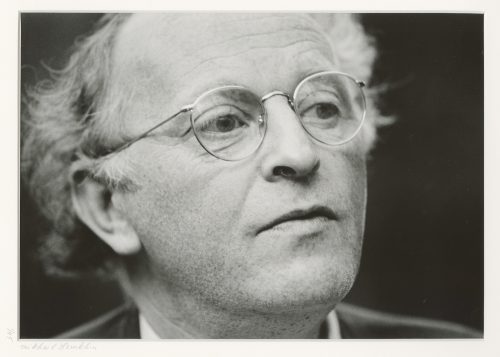 Photographic portrait of poet Joseph Brodsky, head and shoulders, three-quarters to the right, wearing glasses. Pencil-signed on the mat: 1/45 • Mikhail Lemkhin; same inscription on the back of the print, and ink stamp ©Mikhail Lemkhin. Sitter: Joseph Brodsky [Иосиф Александрович Бродский ] (Russian-American-Jewish, 1940 – 1996). Size: mat: 40.5 x 51 cm; window: 24.5 x 35 cm; print: 27.7 x 35.4 cm.
Photographic portrait of poet Joseph Brodsky, head and shoulders, three-quarters to the right, wearing glasses. Pencil-signed on the mat: 1/45 • Mikhail Lemkhin; same inscription on the back of the print, and ink stamp ©Mikhail Lemkhin. Sitter: Joseph Brodsky [Иосиф Александрович Бродский ] (Russian-American-Jewish, 1940 – 1996). Size: mat: 40.5 x 51 cm; window: 24.5 x 35 cm; print: 27.7 x 35.4 cm. -
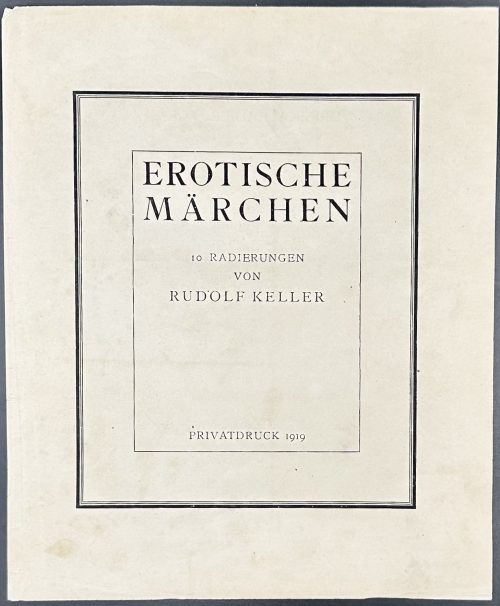 Portfolio 265 x 225 mm, black half-buckram over diapered cardboard with flaps, black with gilt lettering in frame to front “R. KELLER | MÄRCHEN”, t.p. printed on wave paper, the folder and engravings printed on laid paper, 10 loose plates, 240 x 210 mm sheet, 135 x 110-115 mm plate; re-issue of ten plates of the first edition of 16 plates published in Austria in c. 1910s. Title-page: EROTISCHE | MÄRCHEN | 10 RADIERUNGEN | VON | RUDOLF KELLER | PRIVATDRUCK 1919 || Die Mappe enthält folgende originalradierungen: 1. Aschenbrödel; 2. Dornröschen; 3. Zwerg Nase; 4. Froschkönig; 5. Der gestiefelte Kater; 6. Hänsel und Gretel; 7. Der fliegende Koffer; 8. Schneewittchen mit den 7 Zwergen; 9. Die kleine Seejungfer; 10. Der kleine Daumling Dieses Werk wurde in einer einmaligen Auflage von 250 numerierten Exemplaren hergestellt und darf nur an Gelehrte und Sammler abgegeben werden. Die Platten wurden vernichtet. Nr. 1—50 sind vom Künstler signierte Vorzugsdrucke. Dieses Exemplar erhielt Nr. 0153. Translation: The folder contains the following original etchings: 1. Cinderella; 2. Sleeping Beauty; 3. Dwarf nose; 4. The Frog Prince; 5. Puss in Boots; 6. Hansel and Gretel; 7. The Flying Trunk; 8. Snow White with the Seven Dwarfs; 9. The Little Mermaid; 10. Little Thumbling. This work was produced in a one-time edition of 250 numbered copies and may only be sold to scholars and collectors. The copperplates were destroyed. Nos. 1-50 are special prints signed by the artist. This copy was given number 0153. Seller's description: Erotische Märchen. S.l., Privatdruck, 1919. In-8, en feuilles, sous chemise demi-chagrin vert recouverte de papier japonais. Recueil de 10 eaux-fortes originales de Rudolf Keller. Ces eaux-fortes érotiques dans les teintes brunes s'inspirent des contes de fées traditionnels comme Cendrillon, La Belle au bois dormant, Hansel et Gretel, Blanche-Neige, Le Petit Poucet etc. Tirage à 250 exemplaires. Chemise défraîchie. Jacob Grimm (German; 1785 – 1863) Wilhelm Grimm (German, 1786 – 1859) Charles Perrault (French, 1628 – 1703) Hans Christian Andersen (Danish, 1805 – 1875)
Portfolio 265 x 225 mm, black half-buckram over diapered cardboard with flaps, black with gilt lettering in frame to front “R. KELLER | MÄRCHEN”, t.p. printed on wave paper, the folder and engravings printed on laid paper, 10 loose plates, 240 x 210 mm sheet, 135 x 110-115 mm plate; re-issue of ten plates of the first edition of 16 plates published in Austria in c. 1910s. Title-page: EROTISCHE | MÄRCHEN | 10 RADIERUNGEN | VON | RUDOLF KELLER | PRIVATDRUCK 1919 || Die Mappe enthält folgende originalradierungen: 1. Aschenbrödel; 2. Dornröschen; 3. Zwerg Nase; 4. Froschkönig; 5. Der gestiefelte Kater; 6. Hänsel und Gretel; 7. Der fliegende Koffer; 8. Schneewittchen mit den 7 Zwergen; 9. Die kleine Seejungfer; 10. Der kleine Daumling Dieses Werk wurde in einer einmaligen Auflage von 250 numerierten Exemplaren hergestellt und darf nur an Gelehrte und Sammler abgegeben werden. Die Platten wurden vernichtet. Nr. 1—50 sind vom Künstler signierte Vorzugsdrucke. Dieses Exemplar erhielt Nr. 0153. Translation: The folder contains the following original etchings: 1. Cinderella; 2. Sleeping Beauty; 3. Dwarf nose; 4. The Frog Prince; 5. Puss in Boots; 6. Hansel and Gretel; 7. The Flying Trunk; 8. Snow White with the Seven Dwarfs; 9. The Little Mermaid; 10. Little Thumbling. This work was produced in a one-time edition of 250 numbered copies and may only be sold to scholars and collectors. The copperplates were destroyed. Nos. 1-50 are special prints signed by the artist. This copy was given number 0153. Seller's description: Erotische Märchen. S.l., Privatdruck, 1919. In-8, en feuilles, sous chemise demi-chagrin vert recouverte de papier japonais. Recueil de 10 eaux-fortes originales de Rudolf Keller. Ces eaux-fortes érotiques dans les teintes brunes s'inspirent des contes de fées traditionnels comme Cendrillon, La Belle au bois dormant, Hansel et Gretel, Blanche-Neige, Le Petit Poucet etc. Tirage à 250 exemplaires. Chemise défraîchie. Jacob Grimm (German; 1785 – 1863) Wilhelm Grimm (German, 1786 – 1859) Charles Perrault (French, 1628 – 1703) Hans Christian Andersen (Danish, 1805 – 1875) -
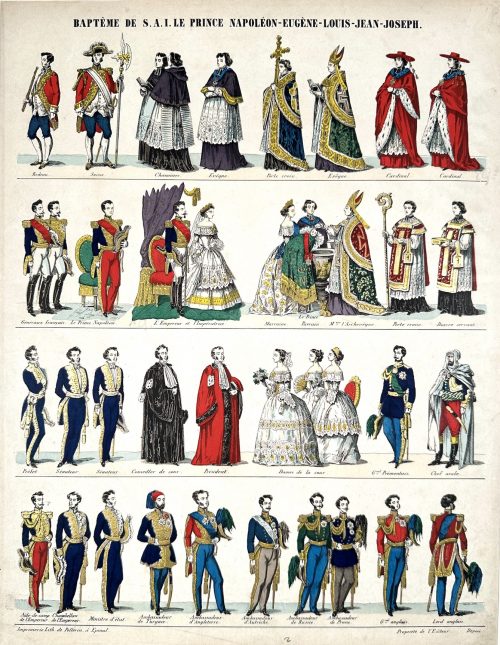 Hand-coloured woodcut on wove paper, 460 x 363 mm; black ink stamp “5054” to reverse. Four tiers with groups of people dressed in uniform, captioned: Bedeau — Suisse — Chanoines — Évêque — Porte croix — Évêque — Cardinal — Cardinal | Généraux français — Le prince Napoléon — L’Empereur et l’Impératrice — Marraine — Le Prince — Parrain | Meur l’Archevêque | Porte crosse Diacre servant | Préfet — Sénateur — Conseiller de cour — Président — Dames de la cour — Gral Piémontais — Chef arabe | Aide-de-camp de l’Empereur — Chambellan de l’Empereur — Ministre d’état — Ambassadeur de Turque | Ambassadeur d’Angleterre — Ambassadeur d’Autriche — Ambassadeur de Russie — Ambassadeur de Prusse — Gral anglaise — Lord anglais || Bottom left: Imprimerie Lith. de Pellerin, à Épinal; right: Propriété de l’Éditeur. — Déposé. Jean Charles Pellerin (French, 1756 – 1836) – printer/publisher.
Hand-coloured woodcut on wove paper, 460 x 363 mm; black ink stamp “5054” to reverse. Four tiers with groups of people dressed in uniform, captioned: Bedeau — Suisse — Chanoines — Évêque — Porte croix — Évêque — Cardinal — Cardinal | Généraux français — Le prince Napoléon — L’Empereur et l’Impératrice — Marraine — Le Prince — Parrain | Meur l’Archevêque | Porte crosse Diacre servant | Préfet — Sénateur — Conseiller de cour — Président — Dames de la cour — Gral Piémontais — Chef arabe | Aide-de-camp de l’Empereur — Chambellan de l’Empereur — Ministre d’état — Ambassadeur de Turque | Ambassadeur d’Angleterre — Ambassadeur d’Autriche — Ambassadeur de Russie — Ambassadeur de Prusse — Gral anglaise — Lord anglais || Bottom left: Imprimerie Lith. de Pellerin, à Épinal; right: Propriété de l’Éditeur. — Déposé. Jean Charles Pellerin (French, 1756 – 1836) – printer/publisher. -
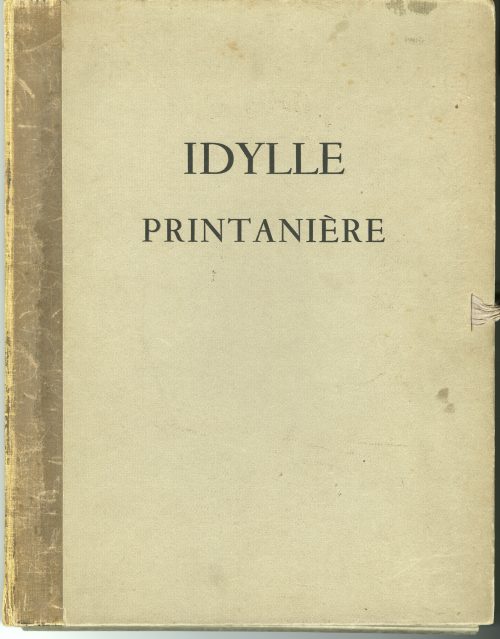 Title: IDYLLE | PRINTANIÈRE || Verso: {Headpiece} | Justification du tirage | {7 lines of text} | Exemplaire № 56 (digits by hand) | HP (monogram by hand) | {tailpiece} || Album of 30 hand-coloured lithographs and frontispiece in a cardboard folder; each sheet mounted in a 32.5 x 25 cm passepartout with 19 x 13 cm window; published in Paris in 1938 by Henri Pasquinelli (attributed). No artist, no publisher name indicated. According to Justification du tirage, the print run of 516 copies on Arches laid tinted paper (vergé), copy A – control artist’s uncoloured, 15 copies B–P reserved for collaborators and friends, copies 1–500 – for bibliophiles. This copy № 56, autographed by the publisher's monogram: "HP". Catalogue Raisonné: J.-P. Dutel, vol 2 (1920–1970), #1726, p. 207-8. Provenance: J.-P. Dutel.
Title: IDYLLE | PRINTANIÈRE || Verso: {Headpiece} | Justification du tirage | {7 lines of text} | Exemplaire № 56 (digits by hand) | HP (monogram by hand) | {tailpiece} || Album of 30 hand-coloured lithographs and frontispiece in a cardboard folder; each sheet mounted in a 32.5 x 25 cm passepartout with 19 x 13 cm window; published in Paris in 1938 by Henri Pasquinelli (attributed). No artist, no publisher name indicated. According to Justification du tirage, the print run of 516 copies on Arches laid tinted paper (vergé), copy A – control artist’s uncoloured, 15 copies B–P reserved for collaborators and friends, copies 1–500 – for bibliophiles. This copy № 56, autographed by the publisher's monogram: "HP". Catalogue Raisonné: J.-P. Dutel, vol 2 (1920–1970), #1726, p. 207-8. Provenance: J.-P. Dutel. -
 Artist: Utagawa Kunisada [歌川 国貞] a.k.a. Utagawa Toyokuni III [三代歌川豊国] (Japanese, 1786 – 1865). Publisher: Iseya Sōemon [伊勢屋惣右衛門] (Japanese, c. 1776 – 1862). Signed: Kunisada ga within a double toshidama. Date-kiwame seals: Bunsei 11 (1828).
Artist: Utagawa Kunisada [歌川 国貞] a.k.a. Utagawa Toyokuni III [三代歌川豊国] (Japanese, 1786 – 1865). Publisher: Iseya Sōemon [伊勢屋惣右衛門] (Japanese, c. 1776 – 1862). Signed: Kunisada ga within a double toshidama. Date-kiwame seals: Bunsei 11 (1828). -
 Katsukawa Shun'ei. The Sumo Bout between Yotsuguruma (right) and Yamaoroshi (left). Date: 1800 or 1805/06. Similar sheet can be found at Edo Tokyo Museum. Size: Vertical Ōban. Sumo wrestler Yotsuguruma Daihachi (1772 - 1809) first appeared in the records of national tournaments in winter of 1794. Then he lost 3 matches and won zero. He first won in the spring tournament of 1797 in a match against maegashira (the fifth-highest rank of sumo wrestlers) named Kougamine. Yamaoroshi Gengo (born 1762) came in at the winter tournament of 1799 . He was much more successful in his career than Yotsuguruma, but he had never won a tournament. It was the time of great Raiden, who won most of them. In the spring tournament of 1800 Yotsuguruma and Yamaoroshi fought against each other for the first time. Yotsuguruma lost. The next time they met on the ring was at the winter tournament of 1805, and again in 1806. Both matches were won by Yamaoroshi. Yamaoroshi retired in 1809; Yotsuguruma died in 1809.
Katsukawa Shun'ei. The Sumo Bout between Yotsuguruma (right) and Yamaoroshi (left). Date: 1800 or 1805/06. Similar sheet can be found at Edo Tokyo Museum. Size: Vertical Ōban. Sumo wrestler Yotsuguruma Daihachi (1772 - 1809) first appeared in the records of national tournaments in winter of 1794. Then he lost 3 matches and won zero. He first won in the spring tournament of 1797 in a match against maegashira (the fifth-highest rank of sumo wrestlers) named Kougamine. Yamaoroshi Gengo (born 1762) came in at the winter tournament of 1799 . He was much more successful in his career than Yotsuguruma, but he had never won a tournament. It was the time of great Raiden, who won most of them. In the spring tournament of 1800 Yotsuguruma and Yamaoroshi fought against each other for the first time. Yotsuguruma lost. The next time they met on the ring was at the winter tournament of 1805, and again in 1806. Both matches were won by Yamaoroshi. Yamaoroshi retired in 1809; Yotsuguruma died in 1809. -
 Untrimmed fan print (uchiwa-e), 231 x 300 mm. Title: A geisha eating edamame aboard the boat of the Atari-ya teahouse. Series: Three summer women [九夏三婦久] (Kyūka sanfuku). Artist: Utagawa Kunisada [歌川 国貞] a.k.a. Utagawa Toyokuni III [三代歌川豊国] (Japanese, 1786 – 1865). Artist: Utagawa Kunihisa II [歌川国久] a.k.a. Katsuda Hisatarō, Ichiunsai, Ritchōrō, Toyonobu, Yōryūsai, Yōsai] (Japanese, 1832 – 1981). Block cutter: Yokokawa Horitake [横川彫武] a.k.a. Yokokawa Takejiro [横川竹二郎] (Japanese, fl. 1860s). Publisher: Ibaya Senzaburō [伊場屋仙三郎] (Japanese, fl. C. 1845 – 1847) Combined date seal and kiwame censor seal: 1860 (Ansei 7 / Man'en 1 from 18/III). Signed: Toyokuni ga in toshidama cartouche, and Kunihisa ga. Provenance: The Collection of Paul F. Walter, Christie's, New York, 2017, lot 341; sol together with 5 other fan prints for $25,000. Before: Israel Goldman, Japanese Prints, Catalogue 9, 2003, no. 35. Ref: [LIB-1693.2018] The Collection of Paul Walter. — NY: Christie's, 2017, p. 363. Ref: Israel Goldman, Catalogue 2018, № 52: "Utagawa Kunisada (1786-1865) and Utagawa Kunihisa II (1832-1891) A Geisha Eating Edamame Aboard the Boat of the Atari-ya Teahouse. From the series Kyuka sanfuku (Three Summer Women). 1860. Fan print. 22.7 x 29.6 cm. Provenance: Israel Goldman, Japanese Prints, Catalogue 9, 2003, no. 35. The Collection of Paul F. Walter, Christies, New York, 201, lot 341. Fine impression, colour and condition. The title is a pun on “kyuka sanpuku” meaning the hottest point of the summer. The background view is by Kunisada’s pupil Kunihisa."
Untrimmed fan print (uchiwa-e), 231 x 300 mm. Title: A geisha eating edamame aboard the boat of the Atari-ya teahouse. Series: Three summer women [九夏三婦久] (Kyūka sanfuku). Artist: Utagawa Kunisada [歌川 国貞] a.k.a. Utagawa Toyokuni III [三代歌川豊国] (Japanese, 1786 – 1865). Artist: Utagawa Kunihisa II [歌川国久] a.k.a. Katsuda Hisatarō, Ichiunsai, Ritchōrō, Toyonobu, Yōryūsai, Yōsai] (Japanese, 1832 – 1981). Block cutter: Yokokawa Horitake [横川彫武] a.k.a. Yokokawa Takejiro [横川竹二郎] (Japanese, fl. 1860s). Publisher: Ibaya Senzaburō [伊場屋仙三郎] (Japanese, fl. C. 1845 – 1847) Combined date seal and kiwame censor seal: 1860 (Ansei 7 / Man'en 1 from 18/III). Signed: Toyokuni ga in toshidama cartouche, and Kunihisa ga. Provenance: The Collection of Paul F. Walter, Christie's, New York, 2017, lot 341; sol together with 5 other fan prints for $25,000. Before: Israel Goldman, Japanese Prints, Catalogue 9, 2003, no. 35. Ref: [LIB-1693.2018] The Collection of Paul Walter. — NY: Christie's, 2017, p. 363. Ref: Israel Goldman, Catalogue 2018, № 52: "Utagawa Kunisada (1786-1865) and Utagawa Kunihisa II (1832-1891) A Geisha Eating Edamame Aboard the Boat of the Atari-ya Teahouse. From the series Kyuka sanfuku (Three Summer Women). 1860. Fan print. 22.7 x 29.6 cm. Provenance: Israel Goldman, Japanese Prints, Catalogue 9, 2003, no. 35. The Collection of Paul F. Walter, Christies, New York, 201, lot 341. Fine impression, colour and condition. The title is a pun on “kyuka sanpuku” meaning the hottest point of the summer. The background view is by Kunisada’s pupil Kunihisa." -
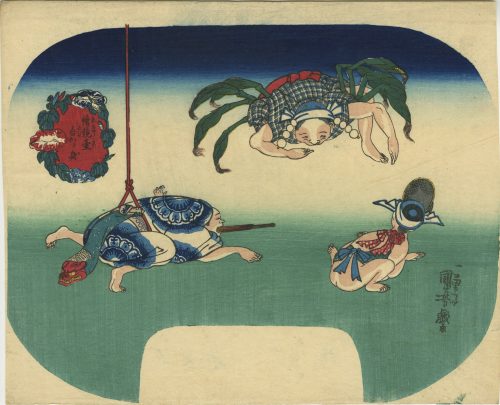 Artist: Utagawa Kuniyoshi [歌川 國芳] (Japanese, 1798 – 1861). Publisher: Ibaya Senzaburō [伊場屋仙三郎] (Japanese, c. 1815 – 1869), no publisher's seal on this print. Another title of this image provided by Sebastian Izzard is Acrobats becoming animals. The series Brother Pictures for Comparison [絵鏡台合かゝ身] (e-kyôdai awase kagami) can be found at Kuniyoshi Project: "This series consists of pairs of fan prints, with one print of each pair being a silhouette of the other. The series is not listed in Kuniyoshi by Basil William Robinson (Victoria and Albert Museum, London, 1961)". The series is attributed to c. 1840. Signed: Ichiyosai Kuniyoshi ga. Size: Size: Uchiwa-e (untrimmed fan print) 227 x 299 mm.
Artist: Utagawa Kuniyoshi [歌川 國芳] (Japanese, 1798 – 1861). Publisher: Ibaya Senzaburō [伊場屋仙三郎] (Japanese, c. 1815 – 1869), no publisher's seal on this print. Another title of this image provided by Sebastian Izzard is Acrobats becoming animals. The series Brother Pictures for Comparison [絵鏡台合かゝ身] (e-kyôdai awase kagami) can be found at Kuniyoshi Project: "This series consists of pairs of fan prints, with one print of each pair being a silhouette of the other. The series is not listed in Kuniyoshi by Basil William Robinson (Victoria and Albert Museum, London, 1961)". The series is attributed to c. 1840. Signed: Ichiyosai Kuniyoshi ga. Size: Size: Uchiwa-e (untrimmed fan print) 227 x 299 mm. -
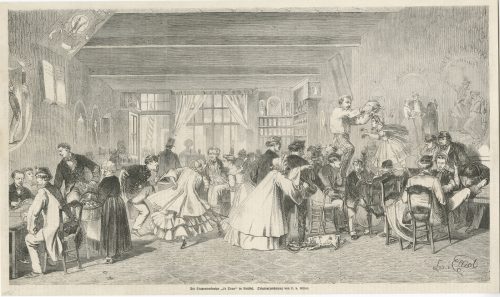
A woodcut illustration after drawing by Leo von Elliot, published at Illustrirte Zeitung, 17 January 1863. English translation: Student bar "The Hole" in Brussels.
The official name of this bar, located at Rue des Sols in Bussels, was "À la vue de l'Université" (In sight of the University). This was the place where the students of the Université libre de Bruxelles (Free University of Brussels), and especially the members of Société, ou Cercle, des Crocodiles (The Crocodile Society, or Circle), gathered in the 1860s. -
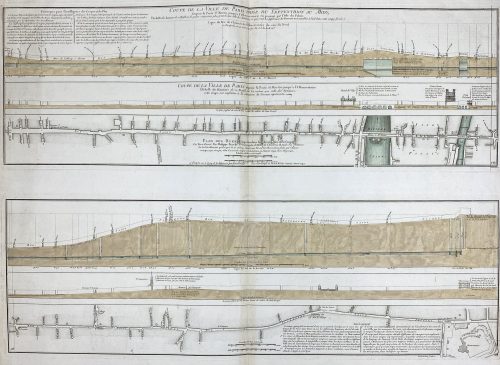
Two prints on one sheet of watermarked laid paper.
Coupe de la ville de Paris prise du septentrion au midy, depuis la porte St Martin jusqu'à l'Observatoire en passant par l'isle du Palais... Coupe de la ville de Paris depuis la porte St Martin jusqu'à l'Observatoire... Plan des rues comprises dans la direction dela coupe... / Le tout dressé par Philippe Buache... ; Desbruslins, sculpsit.
Watermark: "IHS" within circle; countermark of "FIN/ DUPUY/ AUVERGNE 1749".
LOC dates it to 1757. Gallica – to 1742, though the watermark is 1749.
-
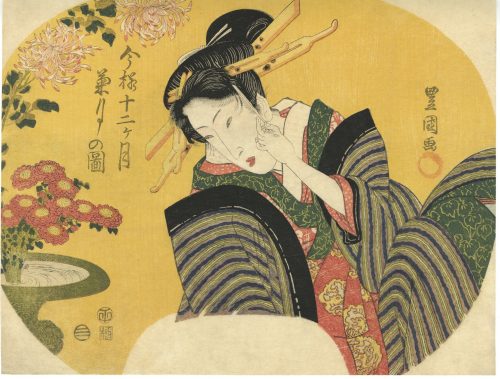 Title: Ninth lunar month [菊月] (Kikuzuki no zu); Series: Fashionable Twelve Months (Imayo juni-kagetsu). Another version of translation: Modern Beauties of Twelve Months. Artist: Utagawa Toyokuni I [歌川豊国] (1769–1825). Pubisher: Ibaya Senzaburō [伊場屋仙三郎] (Japanese, 1815 – 1869), seal: Dansendō [伊場仙]. Signed: Toyokuni ga and sealed with toshidama. Date-kiwame seal: Ushi (ox), Bunsei 5 (1822). Size: double-sheet uncut fan print ( aiban uchiwa-e), 219 x 295 mm.
Title: Ninth lunar month [菊月] (Kikuzuki no zu); Series: Fashionable Twelve Months (Imayo juni-kagetsu). Another version of translation: Modern Beauties of Twelve Months. Artist: Utagawa Toyokuni I [歌川豊国] (1769–1825). Pubisher: Ibaya Senzaburō [伊場屋仙三郎] (Japanese, 1815 – 1869), seal: Dansendō [伊場仙]. Signed: Toyokuni ga and sealed with toshidama. Date-kiwame seal: Ushi (ox), Bunsei 5 (1822). Size: double-sheet uncut fan print ( aiban uchiwa-e), 219 x 295 mm.

-
 Artist: Utagawa Kuniyoshi [歌川 國芳] (Japanese, 1798 – 1861). Publisher: Ibaya Senzaburō [伊場屋仙三郎] (Japanese, c. 1815 – 1869). Date-aratame seal: 1827 (Bunsei 10). Inscription: Ohan [おはん], Chōemon [長右衛門] | Dainingyō [大人形] | Yoshida Senshi [吉田千四)] | unclear (work in progress). Sam. L. Leiter describes the play in his Kabuki Encyclopedia (1979) p. 183, and Japanese traditional theatre (2014), p. 252 as "Love Suicide of Ohan and Choemon at the Katsura River" (Katsuragawa Renri no Shigarami) [桂川連理柵], a two-act play by Suga Sensuke [菅専助] (ca. 1728 – 1791) written in 1776 for the puppet theatre jūruri and adopted for Osaka kabuki in 1777. Yoshida Senshi, a.k.a. Yoshida Bunzaburo III was a Japanese puppeteer of a Yoshida lineage. The line was established by Yoshida Bunzaburō I [吉田文三郎] (Japanese, fl. 1717 – 1760), who was one of the greatest in the history of Bunraku [人形浄瑠璃] (ningyō jōruri) and who around 1734 introduced the three-man puppet manipulation system. A portrait of Yoshida Senshi, who died in 1829, can be found in the Kunisada's triptych at Jordan Schnitzer Museum of Art, ID Number 2016:37.2.).
Artist: Utagawa Kuniyoshi [歌川 國芳] (Japanese, 1798 – 1861). Publisher: Ibaya Senzaburō [伊場屋仙三郎] (Japanese, c. 1815 – 1869). Date-aratame seal: 1827 (Bunsei 10). Inscription: Ohan [おはん], Chōemon [長右衛門] | Dainingyō [大人形] | Yoshida Senshi [吉田千四)] | unclear (work in progress). Sam. L. Leiter describes the play in his Kabuki Encyclopedia (1979) p. 183, and Japanese traditional theatre (2014), p. 252 as "Love Suicide of Ohan and Choemon at the Katsura River" (Katsuragawa Renri no Shigarami) [桂川連理柵], a two-act play by Suga Sensuke [菅専助] (ca. 1728 – 1791) written in 1776 for the puppet theatre jūruri and adopted for Osaka kabuki in 1777. Yoshida Senshi, a.k.a. Yoshida Bunzaburo III was a Japanese puppeteer of a Yoshida lineage. The line was established by Yoshida Bunzaburō I [吉田文三郎] (Japanese, fl. 1717 – 1760), who was one of the greatest in the history of Bunraku [人形浄瑠璃] (ningyō jōruri) and who around 1734 introduced the three-man puppet manipulation system. A portrait of Yoshida Senshi, who died in 1829, can be found in the Kunisada's triptych at Jordan Schnitzer Museum of Art, ID Number 2016:37.2.). The design on our fan print looks very much like the one of Toyokuni I at MFA (Houston): OBJECT NUMBER 2006.378. "Seki Sanjuro as Obiya Choemon and Ichikawa Denzo as Ohan of the Shinonoya from the Kabuki Drama Katsuragawa renri no shigarami (Love Suicide of Ohan and Choemon at the Katsura River)", according to MFA-H published by someone Tsuruya in c. 1810 (though the publisher's seal is Suzuki Ihei [鈴木伊兵衛] (seal name Suzui [鈴伊]), Marks 01-028 | 502; the censor's seal is gyōji, date 1811-14).
The design on our fan print looks very much like the one of Toyokuni I at MFA (Houston): OBJECT NUMBER 2006.378. "Seki Sanjuro as Obiya Choemon and Ichikawa Denzo as Ohan of the Shinonoya from the Kabuki Drama Katsuragawa renri no shigarami (Love Suicide of Ohan and Choemon at the Katsura River)", according to MFA-H published by someone Tsuruya in c. 1810 (though the publisher's seal is Suzuki Ihei [鈴木伊兵衛] (seal name Suzui [鈴伊]), Marks 01-028 | 502; the censor's seal is gyōji, date 1811-14).
 Interestingly enough, the description provided by Kuniyoshi Project is this "Actors: Onoe Kikugorô III as Shinanoya Ohan (おはん, female) and Ichikawa Ebizô V as Obiya Choemon (長右衛門, male). Play: Go chumon shusu no Obiya (御注文繻子帯屋). Date: 3rd month of 1840. Theater: Kawarasaki. Publisher: Iba-ya Sensaburô".
The play Go chumon shusu no Obiya was indeed staged at Kawarazaki theatre in 1840 (Tenpō 11), 3rd month; Ichikawa Ebizō V was indeed playing Obiya Choemon but Onoe Kikugorō III had the role of Kataoka Kōzaemon, not of Ohan, as can be seen on Kunisada's diptych at MFA (Boston): ACCESSION NUMBER 11.40671a-b.
Interestingly enough, the description provided by Kuniyoshi Project is this "Actors: Onoe Kikugorô III as Shinanoya Ohan (おはん, female) and Ichikawa Ebizô V as Obiya Choemon (長右衛門, male). Play: Go chumon shusu no Obiya (御注文繻子帯屋). Date: 3rd month of 1840. Theater: Kawarasaki. Publisher: Iba-ya Sensaburô".
The play Go chumon shusu no Obiya was indeed staged at Kawarazaki theatre in 1840 (Tenpō 11), 3rd month; Ichikawa Ebizō V was indeed playing Obiya Choemon but Onoe Kikugorō III had the role of Kataoka Kōzaemon, not of Ohan, as can be seen on Kunisada's diptych at MFA (Boston): ACCESSION NUMBER 11.40671a-b.

Actors Ichikawa Ebizô V as Obiya Chôemon (R) and Onoe Kikugorô III as Kataoka Kôzaemon (L)
-
 Title: Modori Kago [戻駕] (Returning palanquin). The dance-drama Modori Kago Iro ni Aikata [戻駕色相肩] premiered in the 11th lunar month of 1788 at the Nakamuraza [中村座], within Sakurada Jisuke I's kaomise [顔見世] (faceshowing) program Tôzumô Hana no Edogata [唐相撲花江戸方]", which celebrated the homecoming to Edo, after two years' absence, of Nakamura Nakazō I, and was intended to show off his particular talents in the role of Jirosaku (in reality Ishikawa Goemon [石川 五右衛門]) [kabuki21]. The symbol on a green book cover is the informal crest of tokiwazu-bushi [常磐津節] shaped like a water chestnut (Eleocharis dulcis) lozenge. Artist signature 国盛画 (Kunimori ga) with red toshidama. According to Samuel L. Leiter’s Kabuki Encyclopedia (1979), p. 243: The palanquin bearers Nanpa no Jirosaku and Azuma no Yōshirō, who are bearing a palanquin with a courtesan's young handmaiden in it, stop to rest at Kyoto's Murasakino, and each dances his regional dance. Then they call the girl, who does a dance showing the visitors to the famous pleasure quarters, Yoshiwara and Shimabara. The two men recognize each other as Ishikawa Goemon and Masashiba Hisayoshi, sworn enemies, and engage in a fight. This number is the only remaining section of an annual "faceshowing” (kaomize) work with a plot based on the medieval chronicle called the Toikōki. The full-length piece was called Kara Sumō Hanaeda no Kata. It is one of the most famous tokiwazu pieces and preserves the old-style Kabuki flavour. Nakamura Nakazō I played Jirosaku and Matsumoto Kōshirō IV was Yoshiro in the first production. The handmaiden was Matsumoto Komesaburō (probably Matsumoto Komasaburō I, an unknown actor [SV]). According to Egenolf Gallery: This work was first performed in 1788 at the Edo Nakamura-za as the season’s first performance and featured Nakamura Nakazō, who returned to Edo after three years in Osaka. It was a dance with tokiwazu chanting and was designed for him to play the lead role. In the piece, two palanquin carriers, one from Osaka, another from Edo, and a passenger – a kamuro, (a young geisha-in-training) exchange stories about the pleasure quarters of Shimabara and Yoshiwara. The text of the chanting book is open next to her, carrying the title “Collection of Practicing” [稽古尽くし], on which the green bundle cover carries the crest of Tokiwazu School, matsu-kawa-bishi, diamond variety of pine bark and the artist’s signature. Tokiwazu is a type of jōruri, narrative music, and accompanies dancing on the kabuki stage. Ref.: Christie's 27 Mar 2006. Publisher: Maruya Jinpachi, seal Marujin (Marks: 12-029 | 294e) Single nanushi censor seal: Mura (Murata Sahei, 1842-46). Provenance: Circular seal of the collector Huguette Bérès to verso. Contributors: Utagawa Kunimori [歌川国盛] (Japanese, fl. c. 1818 – 1943) – artist. Maruya Jinpachi [丸屋甚八] (Japanese, fl. 1770 – 1842) – publisher. Other mentioned: Nakamura Nakazō I [中村仲蔵] (Japanese, 1736 – 1790); other names: Nakayama Kojūrō VI, Nakamura Ichijūrō, Nakayama Manzō – actor. Matsumoto Kōshirō IV [松本幸四郎] (Japanese, 1737 – 1802); other names: Omegawa Kyōjūrō; Ichikawa Komazō II, Ichikawa Somegorô I, Ichikawa Takejūrō ; Segawa Kinji; Segawa Kingo – actor. Sakurada Jisuke I [桜田治助] (Japanese, 1734 – 1806) – dramatist.
Title: Modori Kago [戻駕] (Returning palanquin). The dance-drama Modori Kago Iro ni Aikata [戻駕色相肩] premiered in the 11th lunar month of 1788 at the Nakamuraza [中村座], within Sakurada Jisuke I's kaomise [顔見世] (faceshowing) program Tôzumô Hana no Edogata [唐相撲花江戸方]", which celebrated the homecoming to Edo, after two years' absence, of Nakamura Nakazō I, and was intended to show off his particular talents in the role of Jirosaku (in reality Ishikawa Goemon [石川 五右衛門]) [kabuki21]. The symbol on a green book cover is the informal crest of tokiwazu-bushi [常磐津節] shaped like a water chestnut (Eleocharis dulcis) lozenge. Artist signature 国盛画 (Kunimori ga) with red toshidama. According to Samuel L. Leiter’s Kabuki Encyclopedia (1979), p. 243: The palanquin bearers Nanpa no Jirosaku and Azuma no Yōshirō, who are bearing a palanquin with a courtesan's young handmaiden in it, stop to rest at Kyoto's Murasakino, and each dances his regional dance. Then they call the girl, who does a dance showing the visitors to the famous pleasure quarters, Yoshiwara and Shimabara. The two men recognize each other as Ishikawa Goemon and Masashiba Hisayoshi, sworn enemies, and engage in a fight. This number is the only remaining section of an annual "faceshowing” (kaomize) work with a plot based on the medieval chronicle called the Toikōki. The full-length piece was called Kara Sumō Hanaeda no Kata. It is one of the most famous tokiwazu pieces and preserves the old-style Kabuki flavour. Nakamura Nakazō I played Jirosaku and Matsumoto Kōshirō IV was Yoshiro in the first production. The handmaiden was Matsumoto Komesaburō (probably Matsumoto Komasaburō I, an unknown actor [SV]). According to Egenolf Gallery: This work was first performed in 1788 at the Edo Nakamura-za as the season’s first performance and featured Nakamura Nakazō, who returned to Edo after three years in Osaka. It was a dance with tokiwazu chanting and was designed for him to play the lead role. In the piece, two palanquin carriers, one from Osaka, another from Edo, and a passenger – a kamuro, (a young geisha-in-training) exchange stories about the pleasure quarters of Shimabara and Yoshiwara. The text of the chanting book is open next to her, carrying the title “Collection of Practicing” [稽古尽くし], on which the green bundle cover carries the crest of Tokiwazu School, matsu-kawa-bishi, diamond variety of pine bark and the artist’s signature. Tokiwazu is a type of jōruri, narrative music, and accompanies dancing on the kabuki stage. Ref.: Christie's 27 Mar 2006. Publisher: Maruya Jinpachi, seal Marujin (Marks: 12-029 | 294e) Single nanushi censor seal: Mura (Murata Sahei, 1842-46). Provenance: Circular seal of the collector Huguette Bérès to verso. Contributors: Utagawa Kunimori [歌川国盛] (Japanese, fl. c. 1818 – 1943) – artist. Maruya Jinpachi [丸屋甚八] (Japanese, fl. 1770 – 1842) – publisher. Other mentioned: Nakamura Nakazō I [中村仲蔵] (Japanese, 1736 – 1790); other names: Nakayama Kojūrō VI, Nakamura Ichijūrō, Nakayama Manzō – actor. Matsumoto Kōshirō IV [松本幸四郎] (Japanese, 1737 – 1802); other names: Omegawa Kyōjūrō; Ichikawa Komazō II, Ichikawa Somegorô I, Ichikawa Takejūrō ; Segawa Kinji; Segawa Kingo – actor. Sakurada Jisuke I [桜田治助] (Japanese, 1734 – 1806) – dramatist. -
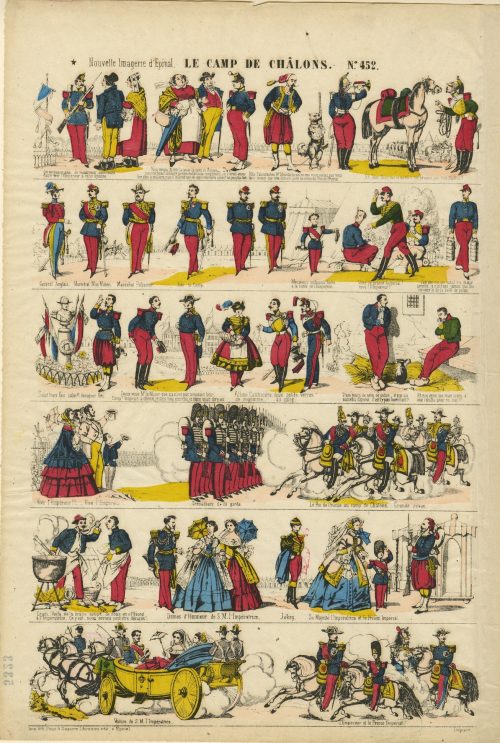 Hand-coloured woodcut on wove paper, 409 x 280 mm; black ink stamp “5323” to reverse; attached to the sheet 487 x 320 mm. Top centre: "LE CAMP DE CHALONS."; left: "Nouvelle Imagerre d'Epinal"; right: № 452. Bottom left: "Imp lith. Pinot & Sagaire, libraires edit. à Épinal"; right: "Déposé". Image: 6-tier cartoon with captions about Napoleon III and his son Prince Imperial (Napoléon Eugène Louis Jean Joseph Bonaparte; 16 March 1856 – 1 June 1879). Le camp de Chalons Pinot & Sagaire (Épinal, 1861 – 1888) – enterprise, publisher/printer. Charles-François Pinot (French, 1817 – 1879) – publisher/printer.
Hand-coloured woodcut on wove paper, 409 x 280 mm; black ink stamp “5323” to reverse; attached to the sheet 487 x 320 mm. Top centre: "LE CAMP DE CHALONS."; left: "Nouvelle Imagerre d'Epinal"; right: № 452. Bottom left: "Imp lith. Pinot & Sagaire, libraires edit. à Épinal"; right: "Déposé". Image: 6-tier cartoon with captions about Napoleon III and his son Prince Imperial (Napoléon Eugène Louis Jean Joseph Bonaparte; 16 March 1856 – 1 June 1879). Le camp de Chalons Pinot & Sagaire (Épinal, 1861 – 1888) – enterprise, publisher/printer. Charles-François Pinot (French, 1817 – 1879) – publisher/printer. -
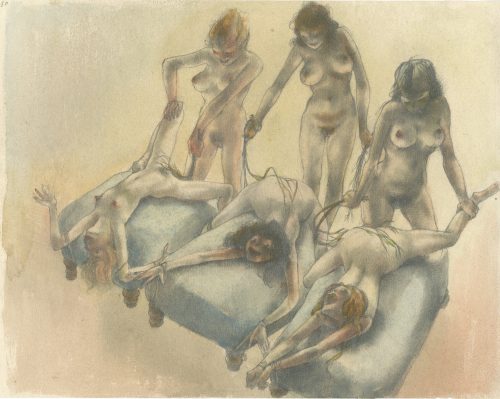 Watercolour on laid paper watermarked “HOLLAND”, 255 x 324 mm, number “10” ms pencil in the upper left corner, remnants of hinges to verso; unsigned. Attributed to Otto Rudolf Schatz (Austrian, 1900 – 1961).
Watercolour on laid paper watermarked “HOLLAND”, 255 x 324 mm, number “10” ms pencil in the upper left corner, remnants of hinges to verso; unsigned. Attributed to Otto Rudolf Schatz (Austrian, 1900 – 1961). -
 Katsukawa Shunshō ( 勝川 春章; 1726 – 19 January 1793).
Katsukawa Shunshō ( 勝川 春章; 1726 – 19 January 1793).SIZE: 12.5 x 5.75 in.
-
 Ichikawa Ebizō III (Matsumoto Kōshirō II, Ichikawa Danjūrō IV, 1711-1778) probably shown as Shinozuka Gorō in the Shibaraku scene of the play Ōyoroi Ebidō Shinozuka, performed at the Nakamura Theater in the 11th month of 1772 (Meiwa 9). This was the occasion when he celebrated his name change, from Matsumoto Kōshirō II to Ichikawa Ebizō III. The lobster or giant shrimp (ebi) upon the Ichikawa family crest (three concentric squares - three measures of rice) on his garment underscores the fact of the name change (ebizō).
Ichikawa Ebizō III (Matsumoto Kōshirō II, Ichikawa Danjūrō IV, 1711-1778) probably shown as Shinozuka Gorō in the Shibaraku scene of the play Ōyoroi Ebidō Shinozuka, performed at the Nakamura Theater in the 11th month of 1772 (Meiwa 9). This was the occasion when he celebrated his name change, from Matsumoto Kōshirō II to Ichikawa Ebizō III. The lobster or giant shrimp (ebi) upon the Ichikawa family crest (three concentric squares - three measures of rice) on his garment underscores the fact of the name change (ebizō). -
 Utagawa Kunisada (Japanese: 歌川 国貞; also known as Utagawa Toyokuni III (三代歌川豊国); 1786 – 12 January 1865).
Utagawa Kunisada (Japanese: 歌川 国貞; also known as Utagawa Toyokuni III (三代歌川豊国); 1786 – 12 January 1865).A young woman reading a book in the light of a lamp. Series: Arigataki miyo no kage-e (Shadow Pictures of an Auspicious Age). There are five known prints, half-length portraits of beauties, in this series, designed by Kunisada in ca. 1844. Another print from the series in this collection: SVJP-0306.2020: A young woman adjusting her hairpins in the light of a paper lantern.
Signed: Kōchōrō Toyokuni ga (香蝶楼豊国画).
Publisher: Maruya Kiyojiro.
Size: Vertical Ōban (37.5 x 25.4 cm). -
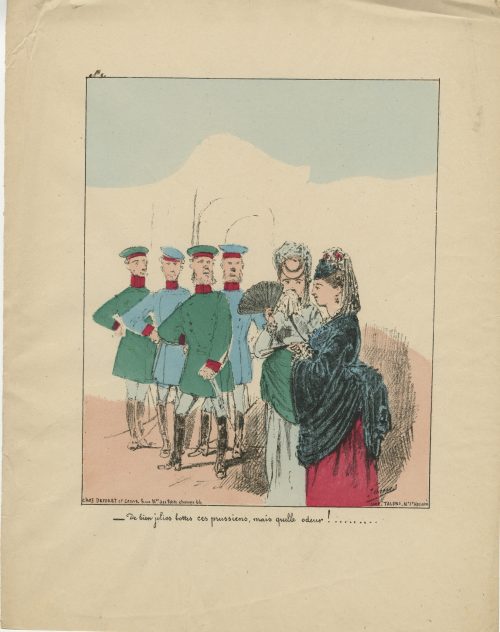 Artist: James (nothing else is known). According to Maurice Quentin-Bouchart (p. 95), this is sheet №2 of only two known caricatures by James except for Collection Wentzell (publisher) of 14 sheets. Text: De bien jolies bottes, ces Prussiens, mais quelle odeur!..... [What beautiful boots these Prussians have, but what an odour!.....] Two women from the bourgeoisie stand in front of a line of Prussian officers. One covers her nose with a handkerchief and hides what she is saying from the men with her fan.
Artist: James (nothing else is known). According to Maurice Quentin-Bouchart (p. 95), this is sheet №2 of only two known caricatures by James except for Collection Wentzell (publisher) of 14 sheets. Text: De bien jolies bottes, ces Prussiens, mais quelle odeur!..... [What beautiful boots these Prussians have, but what an odour!.....] Two women from the bourgeoisie stand in front of a line of Prussian officers. One covers her nose with a handkerchief and hides what she is saying from the men with her fan. -
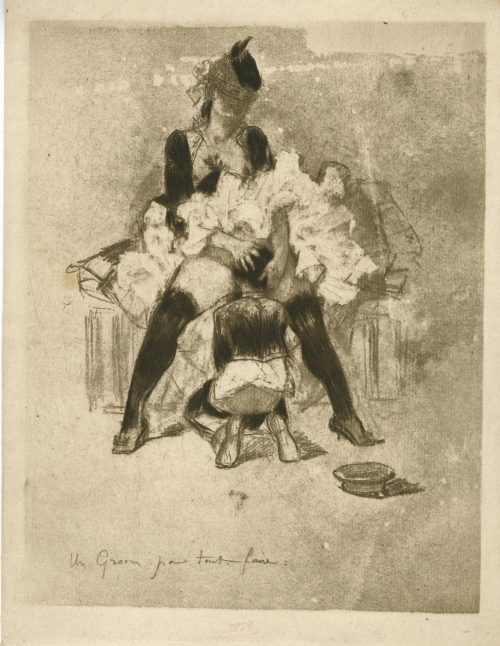
Etching on laid paper, depicting a kneeling groom with his head between the spread legs of a bare-breasted woman in a veiled hat. Inscribed on plate: Un groom a tout faire. Owner's stamp LVM on verso.
Dimensions: Paper: 24.4 x 15.8 cm; Image: 12 x 7.5 cm
Catalogue raisonné: Arthur Hubschmid (1977): 662.
-
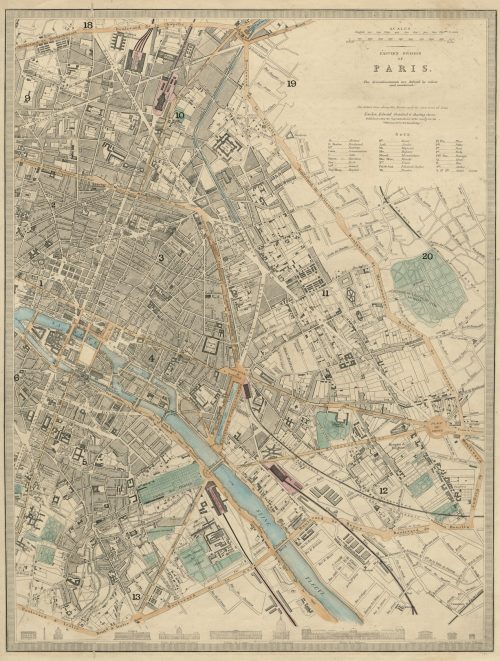 EASTERN DIVISION | OF | PARIS. | The Arrondissements are defined by colour | and numbered. || London, Edward Stanford 6 Charing Cross. | Published under the Superintendence of the Society for the Diffusion of Useful Knowledge. || Dimensions: Sheet: 43.5 x 35.5 cm; Image: 39.5 x 30 cm. Contributors: Edward Stanford (British, 1827 – 1904) – cartographer, engraver, publisher. Society for the Diffusion of Useful Knowledge (SDUK) (British firm, 1826 – 1846).
EASTERN DIVISION | OF | PARIS. | The Arrondissements are defined by colour | and numbered. || London, Edward Stanford 6 Charing Cross. | Published under the Superintendence of the Society for the Diffusion of Useful Knowledge. || Dimensions: Sheet: 43.5 x 35.5 cm; Image: 39.5 x 30 cm. Contributors: Edward Stanford (British, 1827 – 1904) – cartographer, engraver, publisher. Society for the Diffusion of Useful Knowledge (SDUK) (British firm, 1826 – 1846). -
 Okon's Lover Fukuoka Mitsugi, from the series Mirror of Virtuous Women (Teijo misao kagami)「てい女 美作保鏡 おこん 福岡貢」. Artist: Utagawa Kuniyoshi [歌川 國芳] (Japanese, 1798 – 1861). Publisher: Kojimaya Jūbei [小嶋屋重兵衛] (Japanese, fl. c. 1797 – 1869). Year: 1843–47 (Tenpô 14–Kôka 4). Signed: 一勇斎国芳画 – Ichiyûsai Kuniyoshi ga. Censor's seal: Watari. Size: Vertical ôban; 36.8 x 25.6 cm Ref.: MFA № 11.16085.
Okon's Lover Fukuoka Mitsugi, from the series Mirror of Virtuous Women (Teijo misao kagami)「てい女 美作保鏡 おこん 福岡貢」. Artist: Utagawa Kuniyoshi [歌川 國芳] (Japanese, 1798 – 1861). Publisher: Kojimaya Jūbei [小嶋屋重兵衛] (Japanese, fl. c. 1797 – 1869). Year: 1843–47 (Tenpô 14–Kôka 4). Signed: 一勇斎国芳画 – Ichiyûsai Kuniyoshi ga. Censor's seal: Watari. Size: Vertical ôban; 36.8 x 25.6 cm Ref.: MFA № 11.16085. -
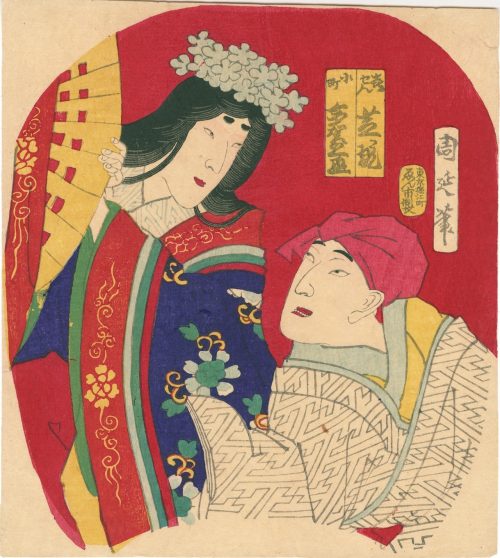 Artist: Toyohara Chikanobu [豊原周延] (Japanese, 1838 – 1912) Signed: Chikanobu hitsu [周延筆] Publisher: [ 東京掘江町] Tokyo Horiemachi | [えん市製] Enshi-sei. Media: Fan print (uchiwa-e, 団扇絵), 192 x 172 mm. Possibly Iwai Kumesaburō IV [岩井粂三郎] (1856 – 1886) a.k.a. Iwai Hisajirō III [岩井久次郎] in the role of Ono no Komachi [小野乃小町] and Nakamura Shikan IV [中村芝翫] in the role of Kisen Hōshi [喜せん法師]. Play: The Six Immortal Poets in Colorful Guises [六歌仙体綵] (Rokkasen Sugata no irodori). Inscription: Left: Kisen [喜せん] | Shikan [芝翫] Right: Komachi [小町] | Kumesaburō [粂三郎]. Actors: Iwai Kumesaburō IV [岩井粂三郎] (1856 – 1886) a.k.a. Iwai Hisajirō III [岩井久次郎]. Nakamura Shikan IV [中村芝翫] (Japanese, 1831 – 1899); other names: Nakamura Fukusuke I [中村福助], Nakamura Masanosuke I, Nakamura Komasaburō, Nakamura Tamatarō I.
Artist: Toyohara Chikanobu [豊原周延] (Japanese, 1838 – 1912) Signed: Chikanobu hitsu [周延筆] Publisher: [ 東京掘江町] Tokyo Horiemachi | [えん市製] Enshi-sei. Media: Fan print (uchiwa-e, 団扇絵), 192 x 172 mm. Possibly Iwai Kumesaburō IV [岩井粂三郎] (1856 – 1886) a.k.a. Iwai Hisajirō III [岩井久次郎] in the role of Ono no Komachi [小野乃小町] and Nakamura Shikan IV [中村芝翫] in the role of Kisen Hōshi [喜せん法師]. Play: The Six Immortal Poets in Colorful Guises [六歌仙体綵] (Rokkasen Sugata no irodori). Inscription: Left: Kisen [喜せん] | Shikan [芝翫] Right: Komachi [小町] | Kumesaburō [粂三郎]. Actors: Iwai Kumesaburō IV [岩井粂三郎] (1856 – 1886) a.k.a. Iwai Hisajirō III [岩井久次郎]. Nakamura Shikan IV [中村芝翫] (Japanese, 1831 – 1899); other names: Nakamura Fukusuke I [中村福助], Nakamura Masanosuke I, Nakamura Komasaburō, Nakamura Tamatarō I. -
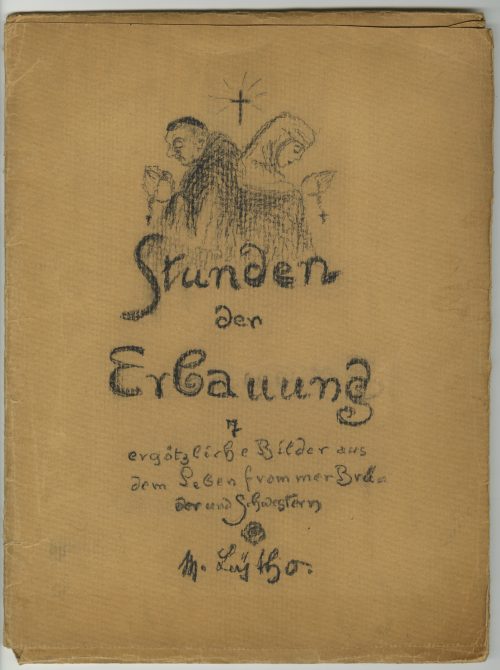 Flapped folder of thick embossed paper 353 x 263 mm, with a vignette and manuscript to front: Stunden der Erbauung | 7 | ergötz liebe Bilder aus | dem Leben frommer Brü | der und Schwestern | • | M. Leÿtho. ||, six graphite pencil drawings, each glued to a paper sheet with guard tissue; mat size 339 x 253 mm mat; drawing size 220 x 165 mm. Translation of the title: Hours of Edification / 7 delightful pictures from the lives of pious brothers and sisters. Information about the artist at www.honesterotica.com: "Mitja Leytho, almost certainly a pseudonym, is yet another mediocre yet fascinating amateur artist from the Germany of the 1920s about whom we know absolutely nothing beyond the four portfolios which bear the ‘Leytho’ signature".
Flapped folder of thick embossed paper 353 x 263 mm, with a vignette and manuscript to front: Stunden der Erbauung | 7 | ergötz liebe Bilder aus | dem Leben frommer Brü | der und Schwestern | • | M. Leÿtho. ||, six graphite pencil drawings, each glued to a paper sheet with guard tissue; mat size 339 x 253 mm mat; drawing size 220 x 165 mm. Translation of the title: Hours of Edification / 7 delightful pictures from the lives of pious brothers and sisters. Information about the artist at www.honesterotica.com: "Mitja Leytho, almost certainly a pseudonym, is yet another mediocre yet fascinating amateur artist from the Germany of the 1920s about whom we know absolutely nothing beyond the four portfolios which bear the ‘Leytho’ signature". -
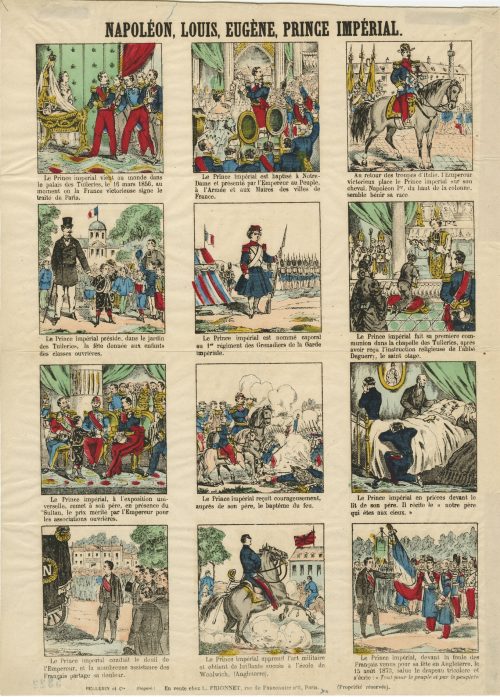 Another copy of SVFC-0745-3.2023, 395 x 290 mm; black ink stamp “5322” to reverse. Jean Charles Pellerin (French, 1756 – 1836)
Another copy of SVFC-0745-3.2023, 395 x 290 mm; black ink stamp “5322” to reverse. Jean Charles Pellerin (French, 1756 – 1836) -
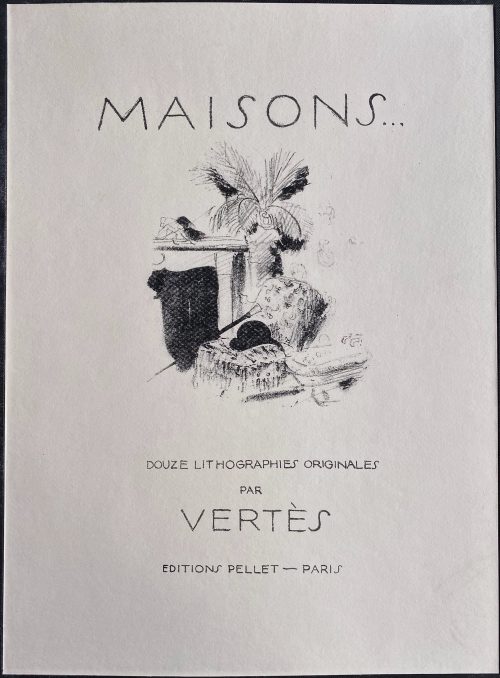 Album in-folio of 13 lithographs by Marcel Vertès, incl. title-page, each in a passe-partout 41.5 x 31.7 cm with 33.0 x 23.0 cm window, printed on wove paper sheets 38.0 x 28.0 cm and crayon-coloured by the artist; graphite pencil drawings by Marcel Vertès on the lower-right corner of each passe-partout; all in a buckram-backed flapped folder, signed ‘AT BOICHOT’, with an uncoloured title-page lithograph on front cover. Edition limited to 100 copies on Chine (№№ 1-100) and 900 on Vélin (№№ 1 to 900); this is a copy № 22 (Vélin), unique as enhanced by the artist. Double-folio leaf 41 x 31 cm with text by Pierre Mac-Orlan. These lithographs, uncoloured, were used in Pierre Mac-Orlan. Les jeux du demi-jour / avec douze lithographies de Vertès. — Paris: Les arts et le livre, 1926 [LIB-2893.2021]. Lithographed title-page: MAISONS.... | {vignette} | DOUZE LITHOGRAPHIES ORIGINALES | PAR | VERTÈS | ÉDITIONS PELLET ~ PARIS || Catalogue raisonné: Vokaer: № 5, p. 7; Nordmann (1): 423, p. 267. Contributors: Pierre Mac-Orlan (French, 1882 – 1970) – author. Marcel Vertès [Marcell Vértes] (Jewish-Hungarian-French, 1895 – 1961) – artist. Gustave Pellet (1859 – 1919) – publisher. Thomas Boichot – bookbinder. Description by J.-P. Dutel: MAC ORLAN Pierre. VERTES Marcel. MAISONS... Douze lithographies originales. Paris, Editions Pellet, [1925]. In-folio (410 x 310 mm) de [4] ff. et 13 lithographies sous passe-partout dont un titre. Chemise en demi-soienoire, premier plat illustré de la même lithographie que celle utilisée pour le titre (AT Boichot). TIRAGE : 100 albums sur chine avant la signature gravée, chaque planche signée. 900 albums sur vélin. :Un des 900 albums sur vélin (n° 22). EXEMPLAIRE UNIQUE DANS LEQUEL LES 13 LITHOGRAPHIES ONT ÉTÉCOLORIÉES AUX CRAYONS DE COULEURS PAR VERTÈS. DE PLUS, CHAQUE PASSE-PARTOUT COMPORTE EN BAS À DROITE UN CROQUIS ORIGINAL À LA MINE DE PLOMB CORRESPONDANT À UNE VERSION PLUS LIBRE DELA LITHO.
Album in-folio of 13 lithographs by Marcel Vertès, incl. title-page, each in a passe-partout 41.5 x 31.7 cm with 33.0 x 23.0 cm window, printed on wove paper sheets 38.0 x 28.0 cm and crayon-coloured by the artist; graphite pencil drawings by Marcel Vertès on the lower-right corner of each passe-partout; all in a buckram-backed flapped folder, signed ‘AT BOICHOT’, with an uncoloured title-page lithograph on front cover. Edition limited to 100 copies on Chine (№№ 1-100) and 900 on Vélin (№№ 1 to 900); this is a copy № 22 (Vélin), unique as enhanced by the artist. Double-folio leaf 41 x 31 cm with text by Pierre Mac-Orlan. These lithographs, uncoloured, were used in Pierre Mac-Orlan. Les jeux du demi-jour / avec douze lithographies de Vertès. — Paris: Les arts et le livre, 1926 [LIB-2893.2021]. Lithographed title-page: MAISONS.... | {vignette} | DOUZE LITHOGRAPHIES ORIGINALES | PAR | VERTÈS | ÉDITIONS PELLET ~ PARIS || Catalogue raisonné: Vokaer: № 5, p. 7; Nordmann (1): 423, p. 267. Contributors: Pierre Mac-Orlan (French, 1882 – 1970) – author. Marcel Vertès [Marcell Vértes] (Jewish-Hungarian-French, 1895 – 1961) – artist. Gustave Pellet (1859 – 1919) – publisher. Thomas Boichot – bookbinder. Description by J.-P. Dutel: MAC ORLAN Pierre. VERTES Marcel. MAISONS... Douze lithographies originales. Paris, Editions Pellet, [1925]. In-folio (410 x 310 mm) de [4] ff. et 13 lithographies sous passe-partout dont un titre. Chemise en demi-soienoire, premier plat illustré de la même lithographie que celle utilisée pour le titre (AT Boichot). TIRAGE : 100 albums sur chine avant la signature gravée, chaque planche signée. 900 albums sur vélin. :Un des 900 albums sur vélin (n° 22). EXEMPLAIRE UNIQUE DANS LEQUEL LES 13 LITHOGRAPHIES ONT ÉTÉCOLORIÉES AUX CRAYONS DE COULEURS PAR VERTÈS. DE PLUS, CHAQUE PASSE-PARTOUT COMPORTE EN BAS À DROITE UN CROQUIS ORIGINAL À LA MINE DE PLOMB CORRESPONDANT À UNE VERSION PLUS LIBRE DELA LITHO. -
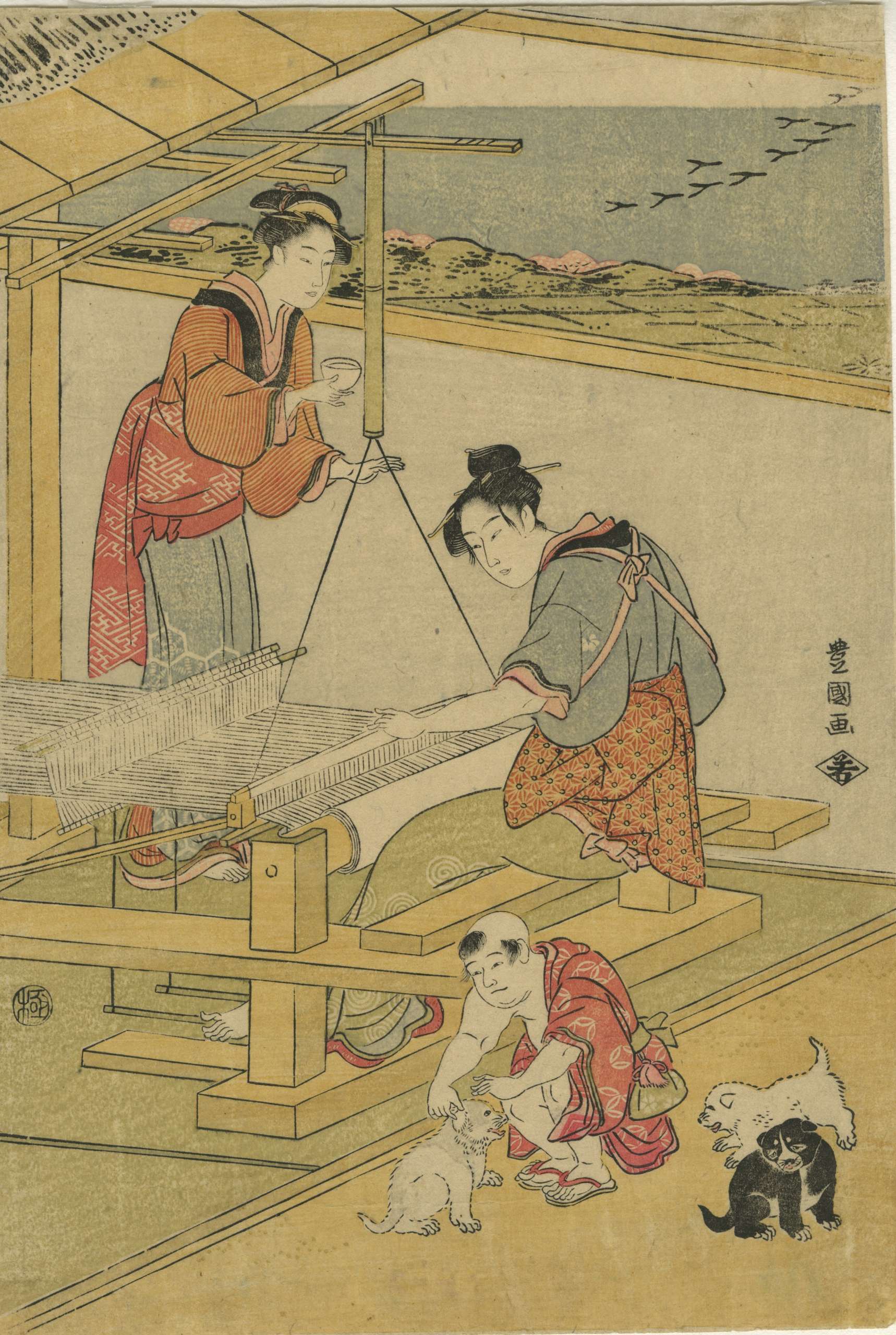 Utagawa Toyokuni I. Women Weaving and Boy Playing with Puppies. c. 1790's. Publisher Wakasaya Yoichi (Jakurindô). Vertical aiban; 32.2 x 21.5 cm (12 11/16 x 8 7/16 in.). MFA ACCESSION NUMBER 06.671. Signed Toyokuni ga 豊国画. Censor's seal: kiwame 改印:極 SOLD
Utagawa Toyokuni I. Women Weaving and Boy Playing with Puppies. c. 1790's. Publisher Wakasaya Yoichi (Jakurindô). Vertical aiban; 32.2 x 21.5 cm (12 11/16 x 8 7/16 in.). MFA ACCESSION NUMBER 06.671. Signed Toyokuni ga 豊国画. Censor's seal: kiwame 改印:極 SOLD -
 Ippitsusai Bunchō (一筆斎文調); lived 1725-1794; flourished 1755–1790. Size: Chuban; 26 x 20 cm The design presents a young woman reading a scroll while arranging her hear, and a young man with a rowing rod watching over her shoulder; the pair is standing on a giant shrimp that ferries them over a stream. The third passenger is a literate octopus, who's is attentively exploring the text of a scroll. This allusion comes to mind promptly: “Bodhidharma crossing the Yangzi River on a reed” (Royō Daruma).
Ippitsusai Bunchō (一筆斎文調); lived 1725-1794; flourished 1755–1790. Size: Chuban; 26 x 20 cm The design presents a young woman reading a scroll while arranging her hear, and a young man with a rowing rod watching over her shoulder; the pair is standing on a giant shrimp that ferries them over a stream. The third passenger is a literate octopus, who's is attentively exploring the text of a scroll. This allusion comes to mind promptly: “Bodhidharma crossing the Yangzi River on a reed” (Royō Daruma). Image from Asian Art Museum in San Francisco:
Image from Asian Art Museum in San Francisco:
Masanobu’s mitate wittily evokes an episode known as “Bodhidharma crossing the Yangzi River on a reed” (Royō Daruma). According to legend, the river crossing occurred en route to the Shaolin monastery, where Bodhidharma sat facing a wall for nine years without speaking. While serious interpretations abound in Chinese and Japanese paintings, popular prints of the Edo period often playfully substituted a beautiful woman for the monk. This parodic version was reportedly invented in response to a courtesan’s comment that she was more enlightened than Bodhidharma because she had spent ten years sitting, on display in a brothel.
An interesting article about this particular design is published at UKIYO-E.ORG BLOG. Though, the design is erroneously attributed to Harunobu. We see that Bunchō was quite fascinated by the idea of crossing a water obstacle with the help of an unsuitable means of transportation:
Female Daruma Riding a Mushroom. MFA # 21.4758.
-
 Katsukawa Shunshō ( 勝川 春章; 1726 – 19 January 1793).
Katsukawa Shunshō ( 勝川 春章; 1726 – 19 January 1793).Signed: Katsukawa Shunshô ga (勝川春章画).
The size is somewhat larger than the standard pillar print (hashira-e): 16.3 x 67.7 cm.
No references found so far.
-
 Artist: Utagawa Sadahide [歌川 貞秀], a.k.a. Gountei Sadahide [五雲亭 貞秀] (1807 – c. 1878/9). Publisher: Iseya Ichiemon [伊勢屋市右衛門] (Japanese, fl. c 1823 – 1864), seal name Kaku-Tsuji [角辻]. Signed: Gountei Sadahide ga [五雲亭貞秀画] Censor's seal: kiwame, date seal: Tenpō 3 (1832). Size: Uncut fan print (uchiwa-e); 218 x 282 mm. Portrait of a young woman dressed in a green kimono decorated with arabesque (karakusa) and flowers, her black obi adorned with a dragon, in a western-style frame, on a blue background; and a painting of a parrot on a pomegranate tree. A similar design was used by Sadahide in 1860, described in detail by Sebastian Izzard in his Japanese Prints of the Mid-Nineteenth Century: 1830–1865, September 20–October 24, 2006 exhibition: Picture of a Curio Shop in Yokohama: reverse painting on glass of a crimson parrot, coloured copperplate engraving of a mother and child (Yokohama urimono mise no zu: gyokuban abura-e, doban-e saishiki). Colour woodblock print: oban tate-e, 143/8 x 93/4 in. (36.5 x 24.8 cm.); Man-en I/3 (3/1860) Series: Picture of Goods for Sale in Yokohama (Yokohama urimono zue no uchi) Signature: Gountei Sadahide ga, double toshidama seal Publisher: Daikokuya Kinnosuke.
Artist: Utagawa Sadahide [歌川 貞秀], a.k.a. Gountei Sadahide [五雲亭 貞秀] (1807 – c. 1878/9). Publisher: Iseya Ichiemon [伊勢屋市右衛門] (Japanese, fl. c 1823 – 1864), seal name Kaku-Tsuji [角辻]. Signed: Gountei Sadahide ga [五雲亭貞秀画] Censor's seal: kiwame, date seal: Tenpō 3 (1832). Size: Uncut fan print (uchiwa-e); 218 x 282 mm. Portrait of a young woman dressed in a green kimono decorated with arabesque (karakusa) and flowers, her black obi adorned with a dragon, in a western-style frame, on a blue background; and a painting of a parrot on a pomegranate tree. A similar design was used by Sadahide in 1860, described in detail by Sebastian Izzard in his Japanese Prints of the Mid-Nineteenth Century: 1830–1865, September 20–October 24, 2006 exhibition: Picture of a Curio Shop in Yokohama: reverse painting on glass of a crimson parrot, coloured copperplate engraving of a mother and child (Yokohama urimono mise no zu: gyokuban abura-e, doban-e saishiki). Colour woodblock print: oban tate-e, 143/8 x 93/4 in. (36.5 x 24.8 cm.); Man-en I/3 (3/1860) Series: Picture of Goods for Sale in Yokohama (Yokohama urimono zue no uchi) Signature: Gountei Sadahide ga, double toshidama seal Publisher: Daikokuya Kinnosuke.
-
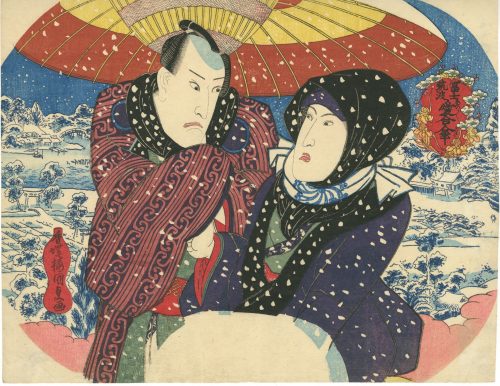 Artist: Utagawa Kunisada [歌川 国貞], a.k.a. Utagawa Toyokuni III [三代 歌川 豊国] (Japanese, 1786 – 1865). An untrimmed fan print titled Fuji Tsukuba aiaigasa, shows the actors Nakamura Shikan II [二代目中村芝翫] and the onnagata actor Iwai Kumesaburō II [岩井粂三郎] sharing an umbrella against the snow. Tsukuba, about 50 kilometres from Edo, was an area where both Fuji and Mount Tsukuba could be viewed together. Mount Fuji being the female and Mount Tsukuba the male. An aizuri-e background (common to all the designs in this set). A play on images and words. Actors: Nakamura Utaemon IV [中村歌右衛門] (Japanese, 1796 – 1852); other names: Nakamura Shikan II [二代目中村芝翫], Nakamura Tsurusuke I, Nakamura Tōtarō. Iwai Hanshirō VI [[岩井半四郎] (Japanese, 1799 – 1836); other names: Iwai Hanshirō VI, Iwai Kumesaburō II [岩井粂三郎], Iwai Hisajirō I, Baiga (poetry name), Shūka (poetry name). Publisher: Ibaya Senzaburo [伊場屋仙三郎] (Japanese, fl. c. 1845 – 1847). Date: circa 1832. Signed: Kōchōrō Kunisada ga in a red double-gourd cartouche. From the series of fan prints:
Artist: Utagawa Kunisada [歌川 国貞], a.k.a. Utagawa Toyokuni III [三代 歌川 豊国] (Japanese, 1786 – 1865). An untrimmed fan print titled Fuji Tsukuba aiaigasa, shows the actors Nakamura Shikan II [二代目中村芝翫] and the onnagata actor Iwai Kumesaburō II [岩井粂三郎] sharing an umbrella against the snow. Tsukuba, about 50 kilometres from Edo, was an area where both Fuji and Mount Tsukuba could be viewed together. Mount Fuji being the female and Mount Tsukuba the male. An aizuri-e background (common to all the designs in this set). A play on images and words. Actors: Nakamura Utaemon IV [中村歌右衛門] (Japanese, 1796 – 1852); other names: Nakamura Shikan II [二代目中村芝翫], Nakamura Tsurusuke I, Nakamura Tōtarō. Iwai Hanshirō VI [[岩井半四郎] (Japanese, 1799 – 1836); other names: Iwai Hanshirō VI, Iwai Kumesaburō II [岩井粂三郎], Iwai Hisajirō I, Baiga (poetry name), Shūka (poetry name). Publisher: Ibaya Senzaburo [伊場屋仙三郎] (Japanese, fl. c. 1845 – 1847). Date: circa 1832. Signed: Kōchōrō Kunisada ga in a red double-gourd cartouche. From the series of fan prints:
Two more prints from the series 'Fuji and Tsukuba sharing an umbrella' (Fuji Tsukuba aiaigasa), not in this Collection:
SVJP-0342.2021

Kabuki actors Onoe Kikugorō III and Iwai Kumesaburo II. Year: c. 1832; Publisher: No seal; Signed: Kōchōrō Kunisada ga From Kunisada Project. 
Kabuki actors Bandō Minosuke II and Iwai Shijaku I. Year: c. 1832; Publisher: No seal; Signed: Kōchōrō Kunisada ga From Kunisada Project. -
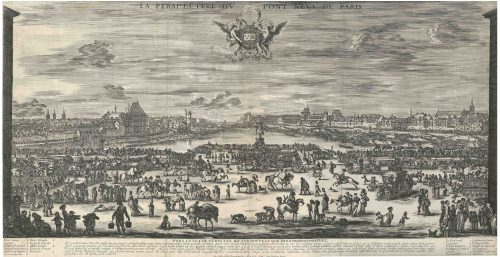
Etching on laid paper, backed. Massar (1971): 59-61. View of the Pont Neuf in Paris, with the statue of Henry IV at centre in front of the Seine, the church of St.-Germaine l'Auxerrois and the Louvre to the right, and the Hôtel de Nevers and Tour de Nesle to the left (MET). in the banner below: LUDOVICO XIIII GALLIARUM ET NAV REGI; below image: PONS LVTETIÆ STRVCTVS, DICTVS NOVVS, ET QVÆ EX EO PROSPICI POSSVNT.; bellow: En pulcherrimus toto ... caufatus, vifere; along the bottom: Ste. Della Bella Florentinus In. e Fecit DD. 1646. Cum Privilegio Regis; additional lettering a lower left and right identifying places depicted.
State: 2nd, with the weathercock on the belltower of Église Saint-Germain l'Auxerrois (under 8). Size: 35.5 x 67.6 cm. Condition: Three vertical folds, these partly cracked and backed at the bottom, dusty or slightly stained, partly slightly rubbed, a small diagonal crease on the upper left, tiny marginal blemishes.Quotation from Phyllis D. Massar. Presenting Stefano della Bella. — NY: The Metropolitan Museum of Art, [1971]: "For size and complexity, one of Della Bella's most impressive achievements is his view of Paris across the Pont Neuf from a point between the buildings bounding the Place Dauphine. Besides the well-known landmarks-the Hộtel de Nevers, the Tour de Nesle, the church of Saint Germain l'Auxerrois, and, at the centre, the bronze equestrian statue of Henri IV by the Florentines Giovanni Bologna and Pietro Tacca – the print provides a microcosm of Paris in transit across the Seine. With a glass, one can compile a census of 451 people, thirty-eight horses, nineteen dogs, three donkeys, and one lamb. All but lost in the vast scene, nevertheless, all contributing to it, are duelists, men fighting with staffs, brawlers routing passers-by, a tooth-puller making an extraction, sellers of sweetmeats and fruits, falconers, hunters with a pack of dogs, a legless cripple, many begging gypsies (one of them telling a fortune), and a hurdy-gurdy player with an audience. Moving among the splendid carriages is a humble water cart, and back among the market stands at the right is an early Seine-side bookstall."
Catalogue raisonné: Massar (1971): pp. 58-61; De Vesme p. 132, № 850ii/ii. Contributor: Stefano della Bella (Italian, 1610 – 1664) – artist and engraver. -
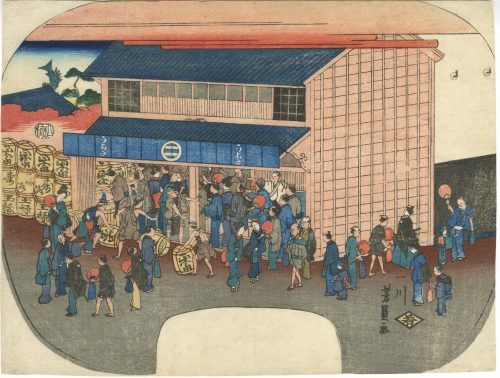 Artist: Utagawa Yoshikazu [歌川芳員] (Japanese, fl. c. 1850 – 1870). Publisher: Wakasaya Yoichi [若狭屋与市] (Japanese, fl. 1794 – 1897). Combined date seal and kiwame censor seal: 1861 (Man'en 2 / Bunkyū 1, from 19/02).
Artist: Utagawa Yoshikazu [歌川芳員] (Japanese, fl. c. 1850 – 1870). Publisher: Wakasaya Yoichi [若狭屋与市] (Japanese, fl. 1794 – 1897). Combined date seal and kiwame censor seal: 1861 (Man'en 2 / Bunkyū 1, from 19/02). -
 Artist: Utagawa Kunisada [歌川 国貞] a.k.a. Utagawa Toyokuni III [三代歌川豊国] (Japanese, 1786 – 1865). Signed: Ōju Toyokuni ga [応需豊国画], in a toshidama cartouche. Double nanushi censor seals Mera & Murata (1846-50). Publisher: Kojimaya Jūbei [小嶋屋重兵衛] (Japanese, fl. c. 1797 – 1869). Kabuki actor Ichikawa Danjūrō VIII [市川団十郎] (Ichikawa Ebizō VI, Ichikawa Shinnosuke II, Japanese, 1823 – 1854) watches the sunrise over Mount Fuji. The complete set of series Moon, Sun, Stars [月日星] (tsuki-hi-hoshi/boshi), three sources of light (sankō) [三光]:
Artist: Utagawa Kunisada [歌川 国貞] a.k.a. Utagawa Toyokuni III [三代歌川豊国] (Japanese, 1786 – 1865). Signed: Ōju Toyokuni ga [応需豊国画], in a toshidama cartouche. Double nanushi censor seals Mera & Murata (1846-50). Publisher: Kojimaya Jūbei [小嶋屋重兵衛] (Japanese, fl. c. 1797 – 1869). Kabuki actor Ichikawa Danjūrō VIII [市川団十郎] (Ichikawa Ebizō VI, Ichikawa Shinnosuke II, Japanese, 1823 – 1854) watches the sunrise over Mount Fuji. The complete set of series Moon, Sun, Stars [月日星] (tsuki-hi-hoshi/boshi), three sources of light (sankō) [三光]: -
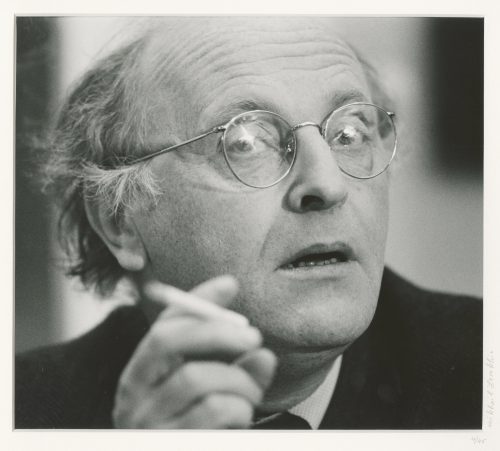 Photographic portrait of poet Joseph Brodsky, head, hand, and shoulder, three-quarters to the right, wearing glasses and with a cigarette. Pencil-signed on the mat: 4/45 • Mikhail Lemkhin; same inscription on the back of the print, and ink stamp ©Mikhail Lemkhin. Sitter: Joseph Brodsky [Иосиф Александрович Бродский ] (Russian-American-Jewish, 1940 – 1996). Size: mat: 40.5 x 51 cm; window: 26.5 x 30 cm; print: 28 x 35.4 cm.
Photographic portrait of poet Joseph Brodsky, head, hand, and shoulder, three-quarters to the right, wearing glasses and with a cigarette. Pencil-signed on the mat: 4/45 • Mikhail Lemkhin; same inscription on the back of the print, and ink stamp ©Mikhail Lemkhin. Sitter: Joseph Brodsky [Иосиф Александрович Бродский ] (Russian-American-Jewish, 1940 – 1996). Size: mat: 40.5 x 51 cm; window: 26.5 x 30 cm; print: 28 x 35.4 cm. -
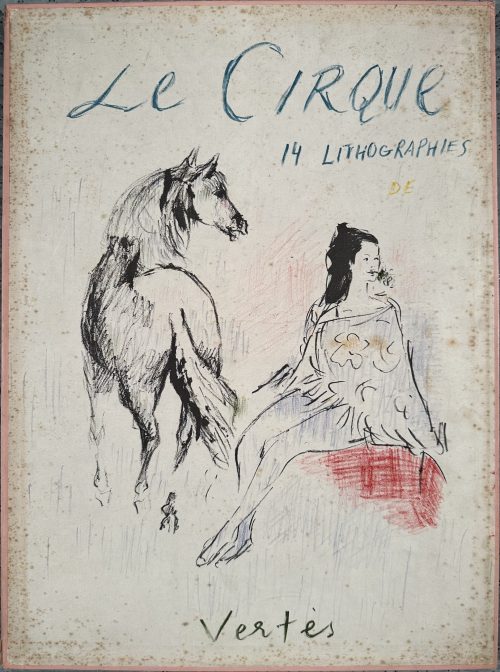 Publisher’s peach cloth box 555 x 410 mm with coloured lithograph on the lid, autographed with crayons "Le Cirque | 14 LITHOGRAPHIES | DE | {vignette} | Vertes"; in-folio unbound 4 pp. booklet on laid paper watermarked “Marais” and 14 loose leaves of plates on laid paper 520 x 395 mm without a watermark with coloured lithographs signed “Vertes” and numbered “195/250” in pencil; interleaved with tracing paper. Box and plates foxed. Title-page (red and black): LE | CIRQUE | 14 LITHOGRAPHIES DE | VERTÈS | PRÉSENTÉ | PAR | JEAN COCTEAU || Imprint: LES LIVES MERVEILLEUX | MONACO | Il a été tiré de cet album : | 150 Exemplaires, | destinés à | l'Amérique, | distribués bar les soins de | Arthur H. Harlow | de New-York, | & | 100 Exemplaires, | réservés à la France. | 15 Avril 1949 || Limitation: Edition limited to 250 copies (150 for USA, 100 for France); this is copy № 195 printed for France as the American copies marked “Published by Arthur H. Harlow & Co., New York. Seller’s Description: VERTÈS, Marcel (Hungarian-French, 1895-1961). Le Cirque 14 Lithographies de Vertès. Présénte par Jean Cocteau. [Monaco: Les Livres Merveilleux, 1949]. [vi] pp. With all 14 lithographs, each signed by the artist and numbered “195/250”. Text and lithographs 15 ¼ x 20 ½”. In original publisher’s peach cloth box with printed label on lid (box foxed, soiled, lightly worn; lithographs and text foxed). Still, a very good example of this lovely collection, with an introduction by Jean Cocteau (1889-1963). Catalogue Raisonné: Vokaer № 50. Marcel Vertès [Marcell Vértes] (Jewish-Hungarian-French, 1895 – 1961) – artist. Arthur H. Harlow (American, c. 1877 – 1958) – publisher. Jean Cocteau (French, 1889 – 1963) – author.
Publisher’s peach cloth box 555 x 410 mm with coloured lithograph on the lid, autographed with crayons "Le Cirque | 14 LITHOGRAPHIES | DE | {vignette} | Vertes"; in-folio unbound 4 pp. booklet on laid paper watermarked “Marais” and 14 loose leaves of plates on laid paper 520 x 395 mm without a watermark with coloured lithographs signed “Vertes” and numbered “195/250” in pencil; interleaved with tracing paper. Box and plates foxed. Title-page (red and black): LE | CIRQUE | 14 LITHOGRAPHIES DE | VERTÈS | PRÉSENTÉ | PAR | JEAN COCTEAU || Imprint: LES LIVES MERVEILLEUX | MONACO | Il a été tiré de cet album : | 150 Exemplaires, | destinés à | l'Amérique, | distribués bar les soins de | Arthur H. Harlow | de New-York, | & | 100 Exemplaires, | réservés à la France. | 15 Avril 1949 || Limitation: Edition limited to 250 copies (150 for USA, 100 for France); this is copy № 195 printed for France as the American copies marked “Published by Arthur H. Harlow & Co., New York. Seller’s Description: VERTÈS, Marcel (Hungarian-French, 1895-1961). Le Cirque 14 Lithographies de Vertès. Présénte par Jean Cocteau. [Monaco: Les Livres Merveilleux, 1949]. [vi] pp. With all 14 lithographs, each signed by the artist and numbered “195/250”. Text and lithographs 15 ¼ x 20 ½”. In original publisher’s peach cloth box with printed label on lid (box foxed, soiled, lightly worn; lithographs and text foxed). Still, a very good example of this lovely collection, with an introduction by Jean Cocteau (1889-1963). Catalogue Raisonné: Vokaer № 50. Marcel Vertès [Marcell Vértes] (Jewish-Hungarian-French, 1895 – 1961) – artist. Arthur H. Harlow (American, c. 1877 – 1958) – publisher. Jean Cocteau (French, 1889 – 1963) – author. -
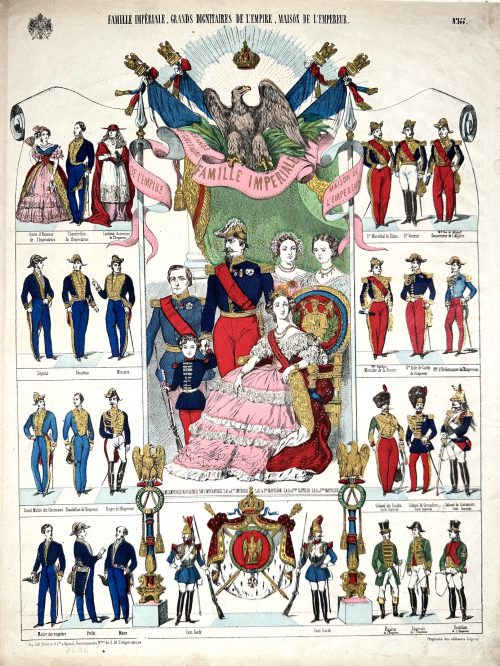 Hand-coloured woodcut on wove paper, 487 x 365 mm; black ink stamp “5056” to reverse. Top left: imperial coat of arms; centre: "FAMILLE IMPERIALE. GRANDS DIGNITAIRES DE L'EMPIRE, MAISON DE L'EMPEREUR."; right: "№144." Image of the imperial family under imperial eagle and standards; besides – four tiers of captioned cartoons. Bottom left: "Imprimerie Lith. de Pellerin, à Épinal"; right: "Propriété de l’Éditeur. — Déposé." Jean Charles Pellerin (French, 1756 – 1836) – printer/publisher.
Hand-coloured woodcut on wove paper, 487 x 365 mm; black ink stamp “5056” to reverse. Top left: imperial coat of arms; centre: "FAMILLE IMPERIALE. GRANDS DIGNITAIRES DE L'EMPIRE, MAISON DE L'EMPEREUR."; right: "№144." Image of the imperial family under imperial eagle and standards; besides – four tiers of captioned cartoons. Bottom left: "Imprimerie Lith. de Pellerin, à Épinal"; right: "Propriété de l’Éditeur. — Déposé." Jean Charles Pellerin (French, 1756 – 1836) – printer/publisher. -
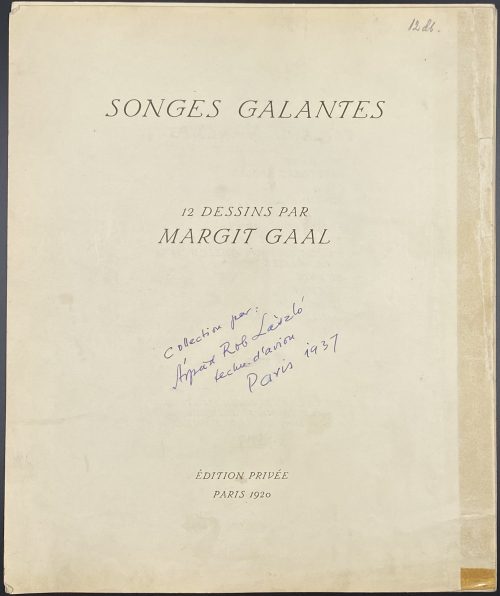 In an owner’s quarter buckram cardboard folder with a vegetation diaper design, ms blue ink lettering to front: “Songes galantes | 12 dessins par | Margit Gaal” at the centre, “Arpad Rob Laszlo | à Paris | 1938” in the lower right corner. Loose sheets with the 1st leaf t.p. / table de planches, and then 12 leaves of lithograph plates. Title-page: SONGES GALANTES | 12 DESSINS PAR | MARGIT GAAL | ÉDITION PRIVÉE | PARIS 1920 ||, ms inscription in blue ink in the middle : “Collection par | Árpad Rob Laśzló | techn. d’avion | Paris 1937”. Limitation: Edition limited to 500 copies of which № 1-100 signed by the author. This is copy № 407. References: Dutel (1920-1970) № 1413 (published in 1921); Honesterotica (indicated the year of death as 1965, however, there is no proof). Contributors: Gaál, Margit (Hungarian, 1898 – 1920) – artist.
In an owner’s quarter buckram cardboard folder with a vegetation diaper design, ms blue ink lettering to front: “Songes galantes | 12 dessins par | Margit Gaal” at the centre, “Arpad Rob Laszlo | à Paris | 1938” in the lower right corner. Loose sheets with the 1st leaf t.p. / table de planches, and then 12 leaves of lithograph plates. Title-page: SONGES GALANTES | 12 DESSINS PAR | MARGIT GAAL | ÉDITION PRIVÉE | PARIS 1920 ||, ms inscription in blue ink in the middle : “Collection par | Árpad Rob Laśzló | techn. d’avion | Paris 1937”. Limitation: Edition limited to 500 copies of which № 1-100 signed by the author. This is copy № 407. References: Dutel (1920-1970) № 1413 (published in 1921); Honesterotica (indicated the year of death as 1965, however, there is no proof). Contributors: Gaál, Margit (Hungarian, 1898 – 1920) – artist. -
 Artist: Utagawa Kunisada [歌川 国貞], a.k.a. Utagawa Toyokuni III [三代 歌川 豊国] (Japanese, 1786 – 1865). Signed: Toyokuni ga [豊国 画] in a red toshidama cartouche Block carver: Yokokawa Takejirō [横川竹二郎] (Japanese, fl. 1845 – 1863), seal: 彫竹 – hori Take. Publisher: Ibaya Senzaburō [伊場屋仙三郎] (Japanese, fl. c. 1845 – 1847). Media: Untrimmed fan print (uchiwa-e), 230 x 295 mm. Combined date seal and kiwame censor seal: Ansei 6 (1859). Title: Princess Sotoori [衣通姫] (Sotoori-hime) – Sotoori-hime was a concubine of Emperor Ingyo (reigned AD 412-53), and one of the Three Gods of Japanese Poetry [和歌三神] (Waka sanjin). Series: Chronicles of Elegant Women [風雅女史傳] (Fūga joshiden). The sign on the torii (Shinto shrine gates) reads: Mountain king shrine [山王宮] – it is the Sannō Shrine at the Nagata Riding Grounds in Edo. A print with these gates is at MFA (Boston) # 21.9853.
Artist: Utagawa Kunisada [歌川 国貞], a.k.a. Utagawa Toyokuni III [三代 歌川 豊国] (Japanese, 1786 – 1865). Signed: Toyokuni ga [豊国 画] in a red toshidama cartouche Block carver: Yokokawa Takejirō [横川竹二郎] (Japanese, fl. 1845 – 1863), seal: 彫竹 – hori Take. Publisher: Ibaya Senzaburō [伊場屋仙三郎] (Japanese, fl. c. 1845 – 1847). Media: Untrimmed fan print (uchiwa-e), 230 x 295 mm. Combined date seal and kiwame censor seal: Ansei 6 (1859). Title: Princess Sotoori [衣通姫] (Sotoori-hime) – Sotoori-hime was a concubine of Emperor Ingyo (reigned AD 412-53), and one of the Three Gods of Japanese Poetry [和歌三神] (Waka sanjin). Series: Chronicles of Elegant Women [風雅女史傳] (Fūga joshiden). The sign on the torii (Shinto shrine gates) reads: Mountain king shrine [山王宮] – it is the Sannō Shrine at the Nagata Riding Grounds in Edo. A print with these gates is at MFA (Boston) # 21.9853. Other prints from the same series in this collection:
SVJP-0343.2021 — Tamagiku:
Other prints from the same series in this collection:
SVJP-0343.2021 — Tamagiku:
 SVJP-0400.2023 — Saiko:
SVJP-0400.2023 — Saiko:
 Note: Special thanks to Horst Graebner, who helped decipher and understand the meaning.
Note: Special thanks to Horst Graebner, who helped decipher and understand the meaning.
-
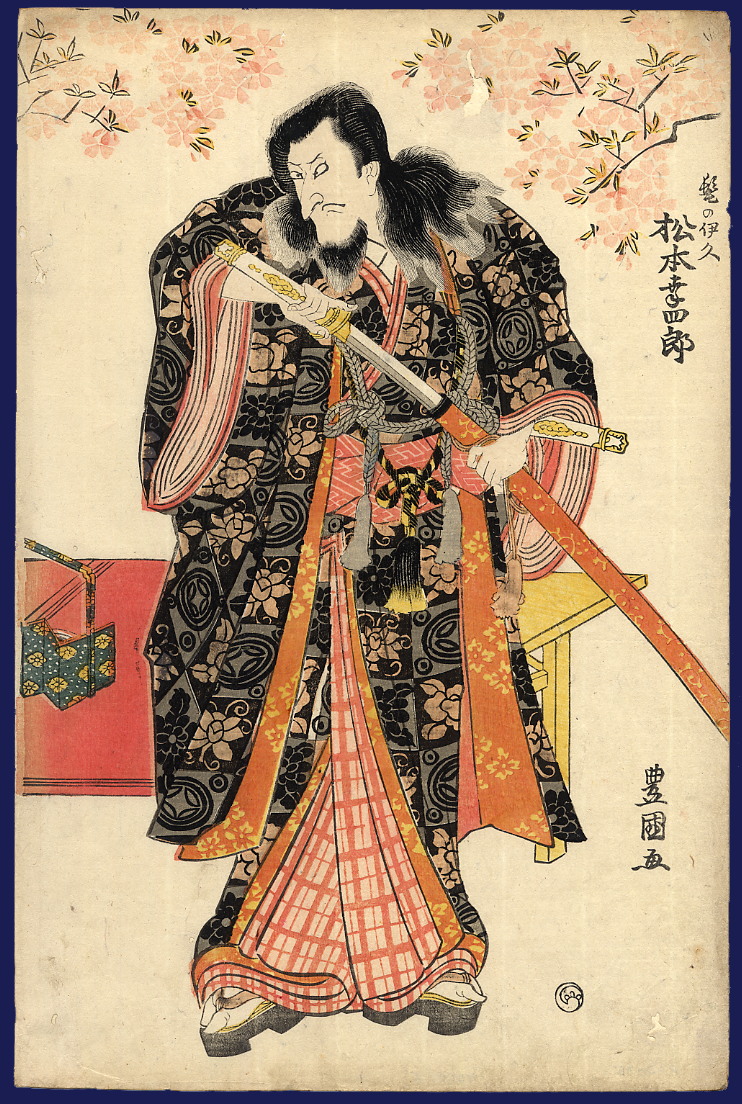 Artist: Utagawa Toyokuni I (1769–1825) Actor Matsumoto Kōshirō V plays the role of Ikyû in the drama "Sukeroku Yukari no Edo Zakura". The roles of Sukeroku and the courtesan Agemaki are played by Ichikawa Danjûrô VII and Iwai Hanshirô V". Ichimura Theater in Edo in 2nd lunar month of 1811. Publisher: Chōjiya Kichi (1811-1826); Marks' "Publishers" № 028, p. 103. Size: Vertical ôban Woodblock print (nishiki-e); ink and color on paper. Signed: Toyokuni ga My print is the right sheet of a triptych (see: Rare books exhibition in January 2013).
Artist: Utagawa Toyokuni I (1769–1825) Actor Matsumoto Kōshirō V plays the role of Ikyû in the drama "Sukeroku Yukari no Edo Zakura". The roles of Sukeroku and the courtesan Agemaki are played by Ichikawa Danjûrô VII and Iwai Hanshirô V". Ichimura Theater in Edo in 2nd lunar month of 1811. Publisher: Chōjiya Kichi (1811-1826); Marks' "Publishers" № 028, p. 103. Size: Vertical ôban Woodblock print (nishiki-e); ink and color on paper. Signed: Toyokuni ga My print is the right sheet of a triptych (see: Rare books exhibition in January 2013). A lookalike triptych by Kunisada can be found in Ronin Gallery:
A lookalike triptych by Kunisada can be found in Ronin Gallery:
 Data from Kabuki21:
Stage names:
Matsumoto Kôshirô V, Ichikawa Komazô III, Ichikawa Sumizô I
Guild: Kôraiya
Line number: GODAIME (V)
Poetry names: Kinshô, Kinkô
Existence: 1764 ~ 10th day of the 5th lunar month of 1838
Connection:
Father: Matsumoto Kôshirô IV
Sons: Matsumoto Kôshirô VI, Ichikawa Sumizô II
Disciples: Matsumoto Kojirô, Matsumoto Kingo I, Matsumoto Hidejûrô II
Data from Kabuki21:
Stage names:
Matsumoto Kôshirô V, Ichikawa Komazô III, Ichikawa Sumizô I
Guild: Kôraiya
Line number: GODAIME (V)
Poetry names: Kinshô, Kinkô
Existence: 1764 ~ 10th day of the 5th lunar month of 1838
Connection:
Father: Matsumoto Kôshirô IV
Sons: Matsumoto Kôshirô VI, Ichikawa Sumizô II
Disciples: Matsumoto Kojirô, Matsumoto Kingo I, Matsumoto Hidejûrô II
Matsumoto Kôshirô V was one of the Kabuki giants, a senryô yakusha, during the Bunka, Bunsei and Tenpô eras. In his 20's he was a tachiyaku actor excelling in nimaime roles like Soga Jûrô Sukenari in sogamono dramas. He started to perform jitsuaku roles from the 11th lunar month of 1798 and quickly became one of the best actors for villain roles, especially in Tsuruya Nanboku IV's kizewamono. He had a considerable influence on actors like Onoe Kikugorô III or Ichikawa Danjûrô VII. The kata he deviced for some of the most famous roles in Kabuki history, like Gonta ("Sushiya") or Nikki Danjô* ("Meiboku Sendai Hagi") are still used nowadays. "The fifth Kôshirô had a very large nose and his eyes were close together, two facial defects the print artists were fond of depicting, so that this Edo actor is easily picked out in the pictures illustrating the theatre of this time." (Zoë Kincaid in "Kabuki, the Popular Stage of Japan")
-
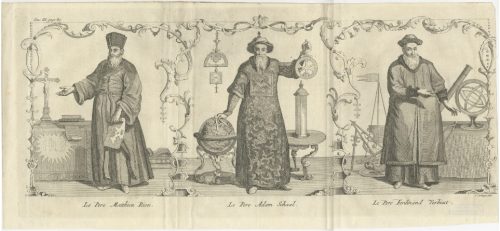
Three priests: Le Pere Matthieu Ricci, Le Pere Adam Schaal, and Le Pere Ferdinand Verbiest. Three priests with navigational instruments. Image taken from Description geographique, historique, chronologique et physique de l'Empire de la Chine et de la Tartarie Chinoise. Enrichies des cartes generales et particulieres de ces pays, etc. by Jean-Baptiste Du Halde (1674–1743), vol. 3, page 78. Originally published/produced in La Haye [The Hague], 1736. J.v.Solingen fecit
Jean-Baptiste Du Halde (Chinese: 杜赫德; 1 February 1674 – 18 August 1743) was a French Jesuit historian specializing in China. He did not travel to China, but collected seventeen Jesuit missionaries' reports and provided an encyclopedic survey of the history, culture and society of China and "Chinese Tartary," that is, Manchuria. Voltaire said of Du Halde's work: "Although it is developed out of Paris, and he hath not known the Chinese, [he] gave on the basis of the memoirs of his colleagues, the widest and the best description the empire of China has had worldwide." Le Pere Matthieu Ricci, a.k.a. Matteo Ricci, S.J. (Italian pronunciation: [matˈtɛːo ˈrittʃi]; Latin: Mattheus Riccius Maceratensis; 6 October 1552 – 11 May 1610), was an Italian Jesuit priest and one of the founding figures of the Jesuit China missions. His 1602 map of the world in Chinese characters introduced the findings of European exploration to East Asia. He is considered a Servant of God by the Roman Catholic Church. Ricci arrived at the Portuguese settlement of Macau in 1582 where he began his missionary work in China. He became the first European to enter the Forbidden City of Beijing in 1601 when invited by the Wanli Emperor, who sought his services in matters such as court astronomy and calendrical science. He converted several prominent Chinese officials to Catholicism, such as Xu Guangqi, who aided in translating Euclid's Elements into Chinese as well as the Confucian classics into Latin for the first time. Le Pere Adam Schaal, a.k.a. Johann Adam Schall von Bell (1 May 1591 – 15 August 1666) was a German Jesuit and astronomer. He spent most of his life as a missionary in China (where he is remembered as "Tang Ruowang") and became an adviser to the Shunzhi Emperor of the Qing dynasty. Le Pere Ferdinand Verbiest, a.k.a. Father Ferdinand Verbiest (9 October 1623 – 28 January 1688) was a Flemish Jesuit missionary in China during the Qing dynasty. He was born in Pittem near Tielt in the County of Flanders (now part of Belgium). He is known as Nan Huairen (南懷仁) in Chinese. He was an accomplished mathematician and astronomer and proved to the court of the Kangxi Emperor that European astronomy was more accurate than Chinese astronomy. He then corrected the Chinese calendar and was later asked to rebuild and re-equip the Beijing Ancient Observatory, being given the role of Head of the Mathematical Board and Director of the Observatory. He became close friends with the Kangxi Emperor, who frequently requested his teaching, in geometry, philosophy and music. Verbiest worked as a diplomat and cartographer, and also as a translator because he spoke Latin, German, Dutch, Spanish, Hebrew, and Italian. He wrote more than thirty books. During the 1670s, Verbiest designed what some claim to be the first ever self-propelled vehicle – many claims this as the world's first automobile, in spite of its small size and the lack of evidence that it was actually built.Joshua Van Solingen was an engraver and publisher from Holland, working, besides other places, in Scotland. Information about him can be found at Catastrophic Bliss (The Griot Project Book Series) by Accounting in Scotland (RLE Accounting): A Historical Bibliography History of the Scottish Metrical Psalms: With an Account of the Paraphrases ... The History of Edinburgh, from the Earliest Accounts to the Present Time ... History of the Bassandyne Bible, the First Printed in Scotland: With Notices ...
-
 Artist: Utagawa Sadahide [歌川 貞秀], a.k.a. Gountei Sadahide [五雲亭 貞秀] (1807 – c. 1878/9). Signed: Gountei Sadahide ga [五雲亭貞秀画] Pubisher: Ibaya Senzaburō [伊場屋仙三郎] (Japanese, 1815 – 1869) Date-aratame seal: Bunsei 13 / Tenpō 1 (1830). Ref: Ritsumeikan University # Z0172-587. Title: Yukari no Edo-zakura [ゆかりの江戸桜], often translated into English as 'The Flower of Edo', is a one-act kabuki play Sukeroku, written by Tsuuchi Han'emon (fl. 1701 – 1743) under the supervision of Tsuuchi Jihei II (1673 – 1760 ) at the beginning of the 18th century. From the beginning of the 19th century, the play was performed in the style of katōbushi. 助六所縁江戸桜(すけろくゆかりのえどざくら。「助六」– one of the main melodies in katōbushi (河東節) type of jōruri [浄瑠璃]. For a detailed explanation in Japanese, see also HERE). Plot: In search of the stolen Minamoto clan's precious sword called Tomokirimaru, Soga Gorō (historical Soga Tokimune [曾我時致], 1174 – 1193) came to a Yoshiwara brothel under the disguise of a debaucher named Hanagawado Sukeroku. His elder brother, Soga Jūrō (historical Soga Sukenari [曾我祐成], 1172 – 1193) ), has assumed the guise of a wine vendor Shinbei. The character who had the Tomokirimaru sword was Ikyū (historical Iga no Heinaizaemon, a Tiara clan's ally), see SVJP-0164.2014. A series of three prints is dedicated to a katōbushi performance of the Soga-themed plays.
Artist: Utagawa Sadahide [歌川 貞秀], a.k.a. Gountei Sadahide [五雲亭 貞秀] (1807 – c. 1878/9). Signed: Gountei Sadahide ga [五雲亭貞秀画] Pubisher: Ibaya Senzaburō [伊場屋仙三郎] (Japanese, 1815 – 1869) Date-aratame seal: Bunsei 13 / Tenpō 1 (1830). Ref: Ritsumeikan University # Z0172-587. Title: Yukari no Edo-zakura [ゆかりの江戸桜], often translated into English as 'The Flower of Edo', is a one-act kabuki play Sukeroku, written by Tsuuchi Han'emon (fl. 1701 – 1743) under the supervision of Tsuuchi Jihei II (1673 – 1760 ) at the beginning of the 18th century. From the beginning of the 19th century, the play was performed in the style of katōbushi. 助六所縁江戸桜(すけろくゆかりのえどざくら。「助六」– one of the main melodies in katōbushi (河東節) type of jōruri [浄瑠璃]. For a detailed explanation in Japanese, see also HERE). Plot: In search of the stolen Minamoto clan's precious sword called Tomokirimaru, Soga Gorō (historical Soga Tokimune [曾我時致], 1174 – 1193) came to a Yoshiwara brothel under the disguise of a debaucher named Hanagawado Sukeroku. His elder brother, Soga Jūrō (historical Soga Sukenari [曾我祐成], 1172 – 1193) ), has assumed the guise of a wine vendor Shinbei. The character who had the Tomokirimaru sword was Ikyū (historical Iga no Heinaizaemon, a Tiara clan's ally), see SVJP-0164.2014. A series of three prints is dedicated to a katōbushi performance of the Soga-themed plays.
They all have a background of hail patterns (Arare-ko-mon) [霰小紋], similar to Kunisada’s Iwai Kumesaburō II as An no Heibei [SVJP-0304.2019], see below.Yukari no Edo-zakura The tatami night robe of Iwao Tangled Hair and the Evening Braided Hat 
-
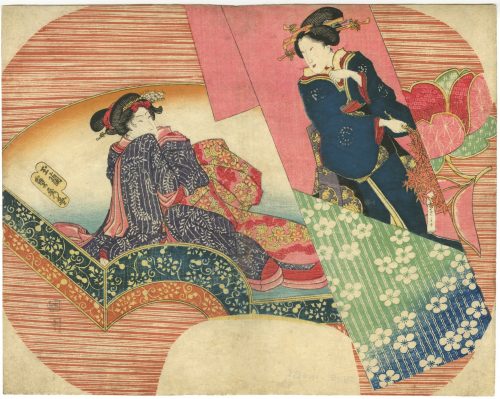 Artist: Utagawa Sadahide [歌川貞秀] (Japanese, 1807 – 1879). Publisher: Kojimaya Jūbei [小島屋重兵衛] (Japanese, c. 1797 – 1869); seal: Marks #264, p. 210) Signed: Gyokuransai Sadahide ga [玉蘭斎貞秀 画]. Date seal: 1830 (Bunsei 13 / Tenpō 1). Size: Uncut fan print (uchiwa-e); 229 x 292 mm
Artist: Utagawa Sadahide [歌川貞秀] (Japanese, 1807 – 1879). Publisher: Kojimaya Jūbei [小島屋重兵衛] (Japanese, c. 1797 – 1869); seal: Marks #264, p. 210) Signed: Gyokuransai Sadahide ga [玉蘭斎貞秀 画]. Date seal: 1830 (Bunsei 13 / Tenpō 1). Size: Uncut fan print (uchiwa-e); 229 x 292 mm -
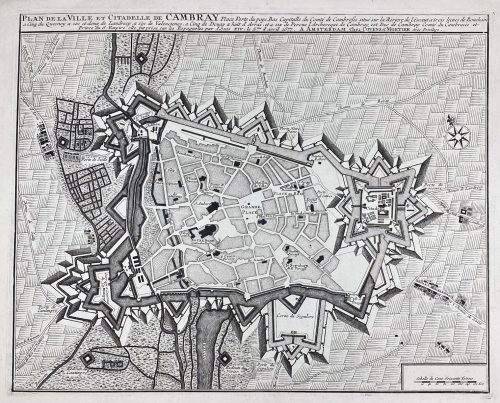
Plan de la ville et citadelle de Cambray : place forte du pays bas capitalle du Comté Cambresis situé sur la riviere de l'Escaut a trois lieues de Bouchain, a cinq du Quesnoy, a six et demy de Landrecy, a six de Valenciene, a cinq de Douay, a huit d'Arras, et a six de Perone, l'Archeveque de Cambray est Duc de Cambray, Comté du Cambresis et Prince du S. Empire, elle fut prix sur les espagnoles par Louis XIV, le 5.me d'April 1677; A AMSTERDAM Chez Covens & Mortier, Avec Privilege.
Date of publication: [between 1721 and 1778].
Dimensions: Sheet: 48 x 58.3 cm; Image: 38.2 x 47.7 cm. Earlier editions of the same were by Pierre Husson in the Hague (ca. 1715) and by Eugene Henry Fricx in Brussels (1710). -
 Title: Gotenyama [御殿山] – one of the most popular cherry blossom viewing spots; it is a hill at Shinagawa [品川], the second station on the Tōkaidō road [東海道], located on the shores of Edo Bay [江戸湾]. Series: A Collection of Mountains [山つくし] (Yama tsukushi) Artist: Utagawa Kunisada [歌川 国貞] a.k.a. Utagawa Toyokuni III [三代歌川豊国] (Japanese, 1786 – 12 January 1865). Block carver: Yokokawa Takejirō, seal: [彫竹] – Hori Take. Publisher: Yama-Ta; seal: [板元, 太] – Hanmoto, Ta; Marks 19-044 | U421b: An unknown publisher in Edo, fl. c. 1815-61. Combined date seal and kiwame censor seal: Ansei 6 (1851). Signed: Toyokuni ga [豊国 画] in a red toshidama cartouche. Size: Fan print (uchiwa-e) 227 x 287 mm.
Title: Gotenyama [御殿山] – one of the most popular cherry blossom viewing spots; it is a hill at Shinagawa [品川], the second station on the Tōkaidō road [東海道], located on the shores of Edo Bay [江戸湾]. Series: A Collection of Mountains [山つくし] (Yama tsukushi) Artist: Utagawa Kunisada [歌川 国貞] a.k.a. Utagawa Toyokuni III [三代歌川豊国] (Japanese, 1786 – 12 January 1865). Block carver: Yokokawa Takejirō, seal: [彫竹] – Hori Take. Publisher: Yama-Ta; seal: [板元, 太] – Hanmoto, Ta; Marks 19-044 | U421b: An unknown publisher in Edo, fl. c. 1815-61. Combined date seal and kiwame censor seal: Ansei 6 (1851). Signed: Toyokuni ga [豊国 画] in a red toshidama cartouche. Size: Fan print (uchiwa-e) 227 x 287 mm.








